Fundamental of Project Management
VerifiedAdded on 2023/01/12
|23
|4678
|79
AI Summary
This article provides a systematic and informative study on project management, addressing critical facets and relevant issues. It includes a case study on Automation Futures (AF) PLC to help businesses reach strategic objectives within a defined timeframe.
Contribute Materials
Your contribution can guide someone’s learning journey. Share your
documents today.
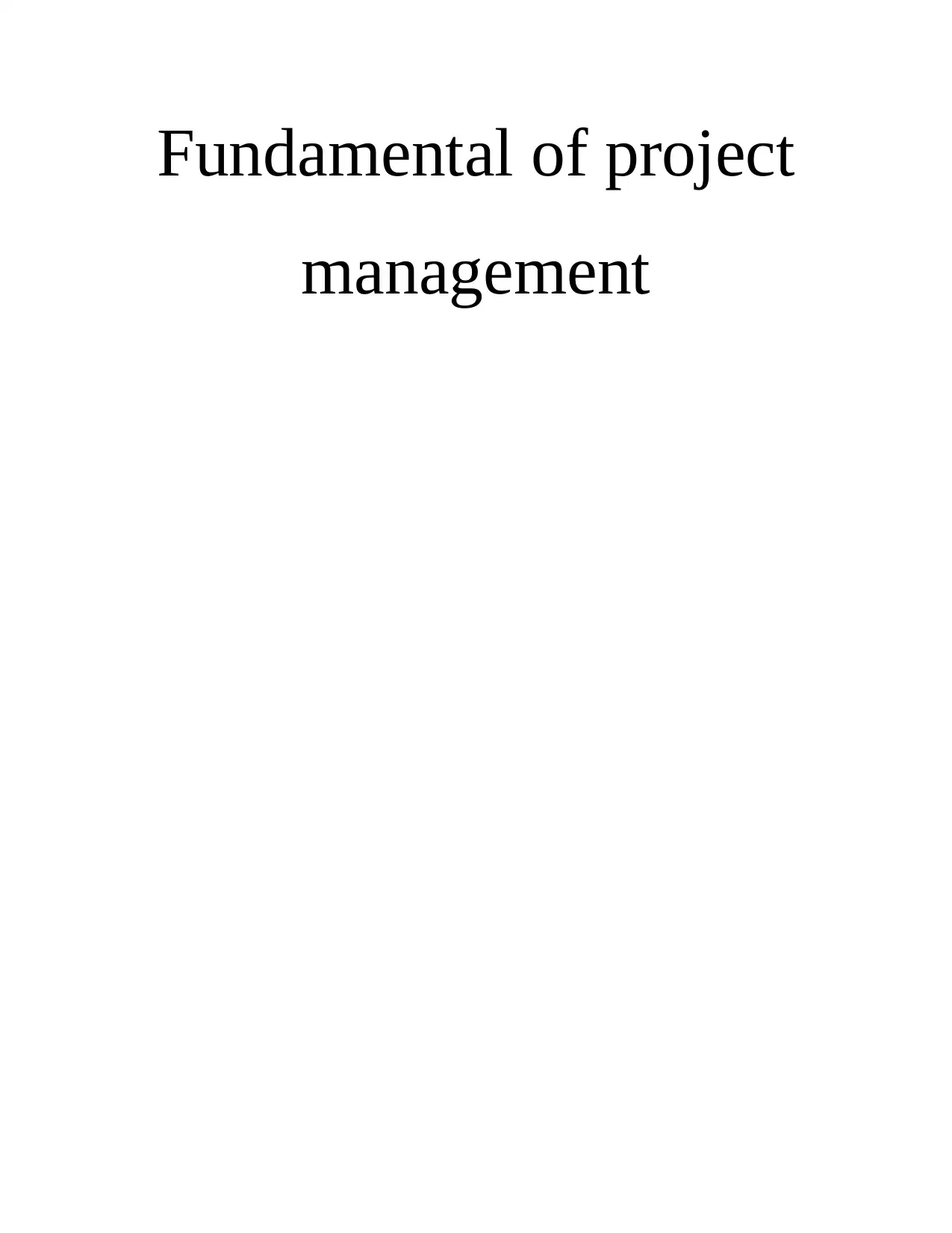
Fundamental of project
management
management
Secure Best Marks with AI Grader
Need help grading? Try our AI Grader for instant feedback on your assignments.
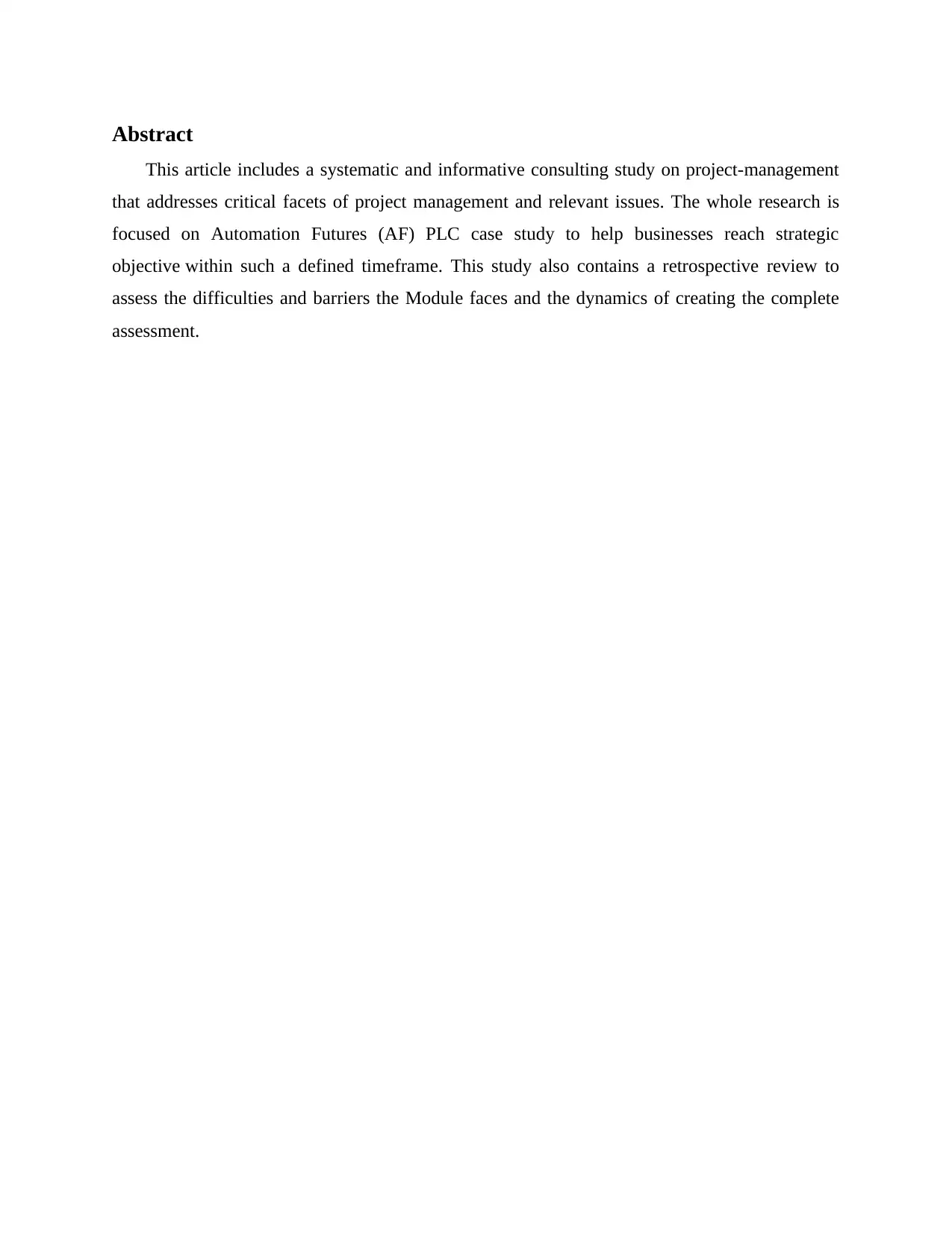
Abstract
This article includes a systematic and informative consulting study on project-management
that addresses critical facets of project management and relevant issues. The whole research is
focused on Automation Futures (AF) PLC case study to help businesses reach strategic
objective within such a defined timeframe. This study also contains a retrospective review to
assess the difficulties and barriers the Module faces and the dynamics of creating the complete
assessment.
This article includes a systematic and informative consulting study on project-management
that addresses critical facets of project management and relevant issues. The whole research is
focused on Automation Futures (AF) PLC case study to help businesses reach strategic
objective within such a defined timeframe. This study also contains a retrospective review to
assess the difficulties and barriers the Module faces and the dynamics of creating the complete
assessment.
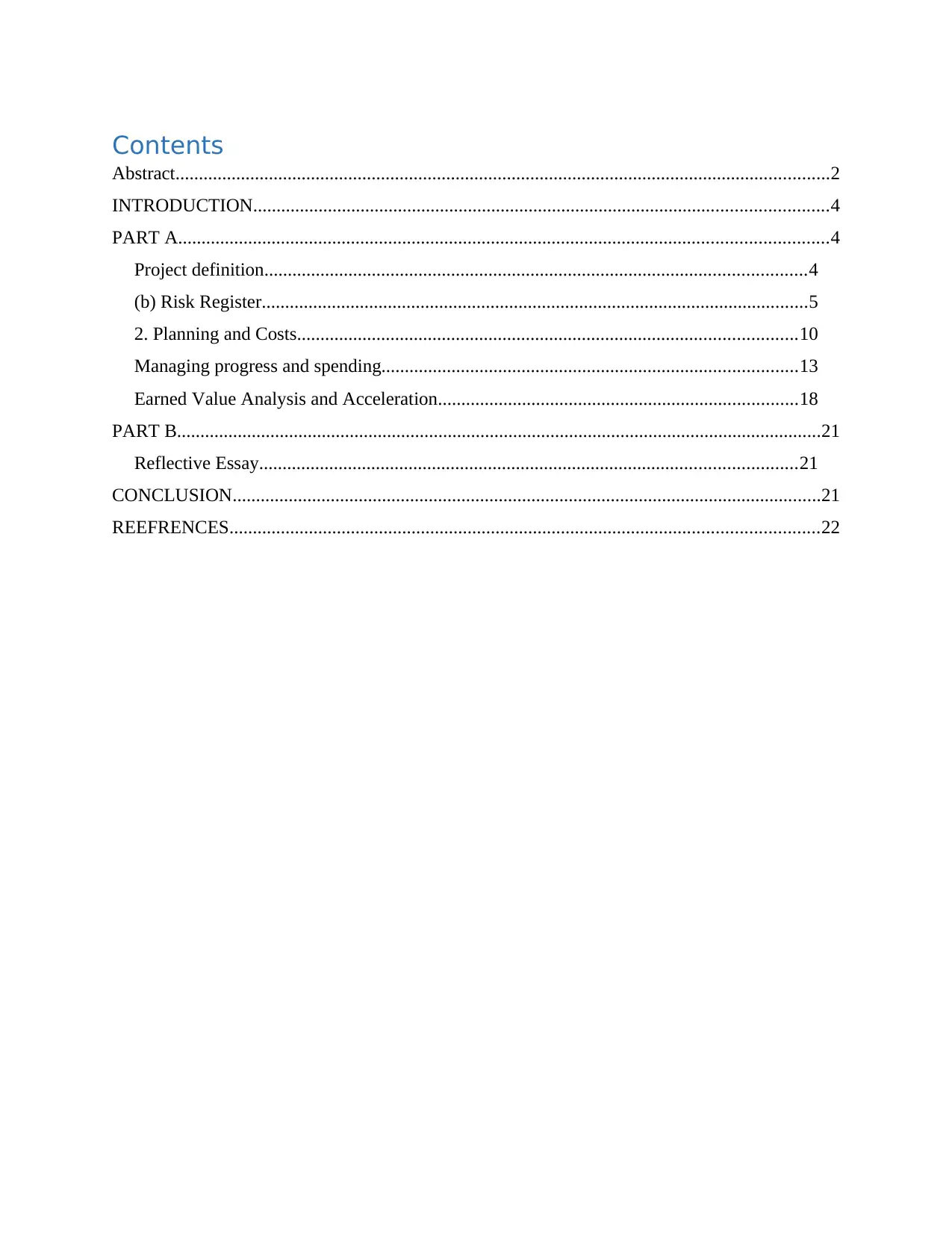
Contents
Abstract............................................................................................................................................2
INTRODUCTION...........................................................................................................................4
PART A...........................................................................................................................................4
Project definition....................................................................................................................4
(b) Risk Register.....................................................................................................................5
2. Planning and Costs...........................................................................................................10
Managing progress and spending.........................................................................................13
Earned Value Analysis and Acceleration.............................................................................18
PART B..........................................................................................................................................21
Reflective Essay...................................................................................................................21
CONCLUSION..............................................................................................................................21
REEFRENCES..............................................................................................................................22
Abstract............................................................................................................................................2
INTRODUCTION...........................................................................................................................4
PART A...........................................................................................................................................4
Project definition....................................................................................................................4
(b) Risk Register.....................................................................................................................5
2. Planning and Costs...........................................................................................................10
Managing progress and spending.........................................................................................13
Earned Value Analysis and Acceleration.............................................................................18
PART B..........................................................................................................................................21
Reflective Essay...................................................................................................................21
CONCLUSION..............................................................................................................................21
REEFRENCES..............................................................................................................................22
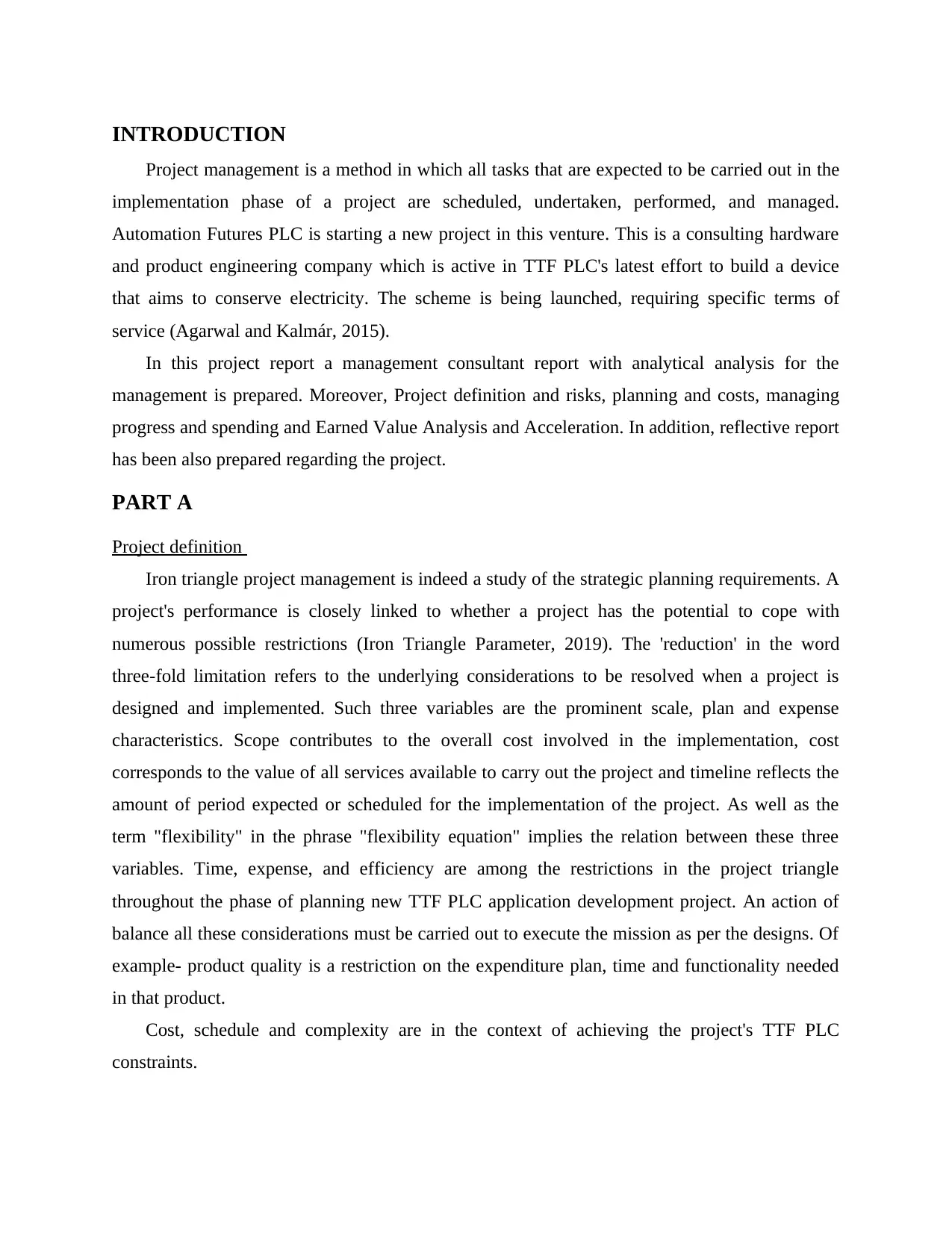
INTRODUCTION
Project management is a method in which all tasks that are expected to be carried out in the
implementation phase of a project are scheduled, undertaken, performed, and managed.
Automation Futures PLC is starting a new project in this venture. This is a consulting hardware
and product engineering company which is active in TTF PLC's latest effort to build a device
that aims to conserve electricity. The scheme is being launched, requiring specific terms of
service (Agarwal and Kalmár, 2015).
In this project report a management consultant report with analytical analysis for the
management is prepared. Moreover, Project definition and risks, planning and costs, managing
progress and spending and Earned Value Analysis and Acceleration. In addition, reflective report
has been also prepared regarding the project.
PART A
Project definition
Iron triangle project management is indeed a study of the strategic planning requirements. A
project's performance is closely linked to whether a project has the potential to cope with
numerous possible restrictions (Iron Triangle Parameter, 2019). The 'reduction' in the word
three-fold limitation refers to the underlying considerations to be resolved when a project is
designed and implemented. Such three variables are the prominent scale, plan and expense
characteristics. Scope contributes to the overall cost involved in the implementation, cost
corresponds to the value of all services available to carry out the project and timeline reflects the
amount of period expected or scheduled for the implementation of the project. As well as the
term "flexibility" in the phrase "flexibility equation" implies the relation between these three
variables. Time, expense, and efficiency are among the restrictions in the project triangle
throughout the phase of planning new TTF PLC application development project. An action of
balance all these considerations must be carried out to execute the mission as per the designs. Of
example- product quality is a restriction on the expenditure plan, time and functionality needed
in that product.
Cost, schedule and complexity are in the context of achieving the project's TTF PLC
constraints.
Project management is a method in which all tasks that are expected to be carried out in the
implementation phase of a project are scheduled, undertaken, performed, and managed.
Automation Futures PLC is starting a new project in this venture. This is a consulting hardware
and product engineering company which is active in TTF PLC's latest effort to build a device
that aims to conserve electricity. The scheme is being launched, requiring specific terms of
service (Agarwal and Kalmár, 2015).
In this project report a management consultant report with analytical analysis for the
management is prepared. Moreover, Project definition and risks, planning and costs, managing
progress and spending and Earned Value Analysis and Acceleration. In addition, reflective report
has been also prepared regarding the project.
PART A
Project definition
Iron triangle project management is indeed a study of the strategic planning requirements. A
project's performance is closely linked to whether a project has the potential to cope with
numerous possible restrictions (Iron Triangle Parameter, 2019). The 'reduction' in the word
three-fold limitation refers to the underlying considerations to be resolved when a project is
designed and implemented. Such three variables are the prominent scale, plan and expense
characteristics. Scope contributes to the overall cost involved in the implementation, cost
corresponds to the value of all services available to carry out the project and timeline reflects the
amount of period expected or scheduled for the implementation of the project. As well as the
term "flexibility" in the phrase "flexibility equation" implies the relation between these three
variables. Time, expense, and efficiency are among the restrictions in the project triangle
throughout the phase of planning new TTF PLC application development project. An action of
balance all these considerations must be carried out to execute the mission as per the designs. Of
example- product quality is a restriction on the expenditure plan, time and functionality needed
in that product.
Cost, schedule and complexity are in the context of achieving the project's TTF PLC
constraints.
Secure Best Marks with AI Grader
Need help grading? Try our AI Grader for instant feedback on your assignments.
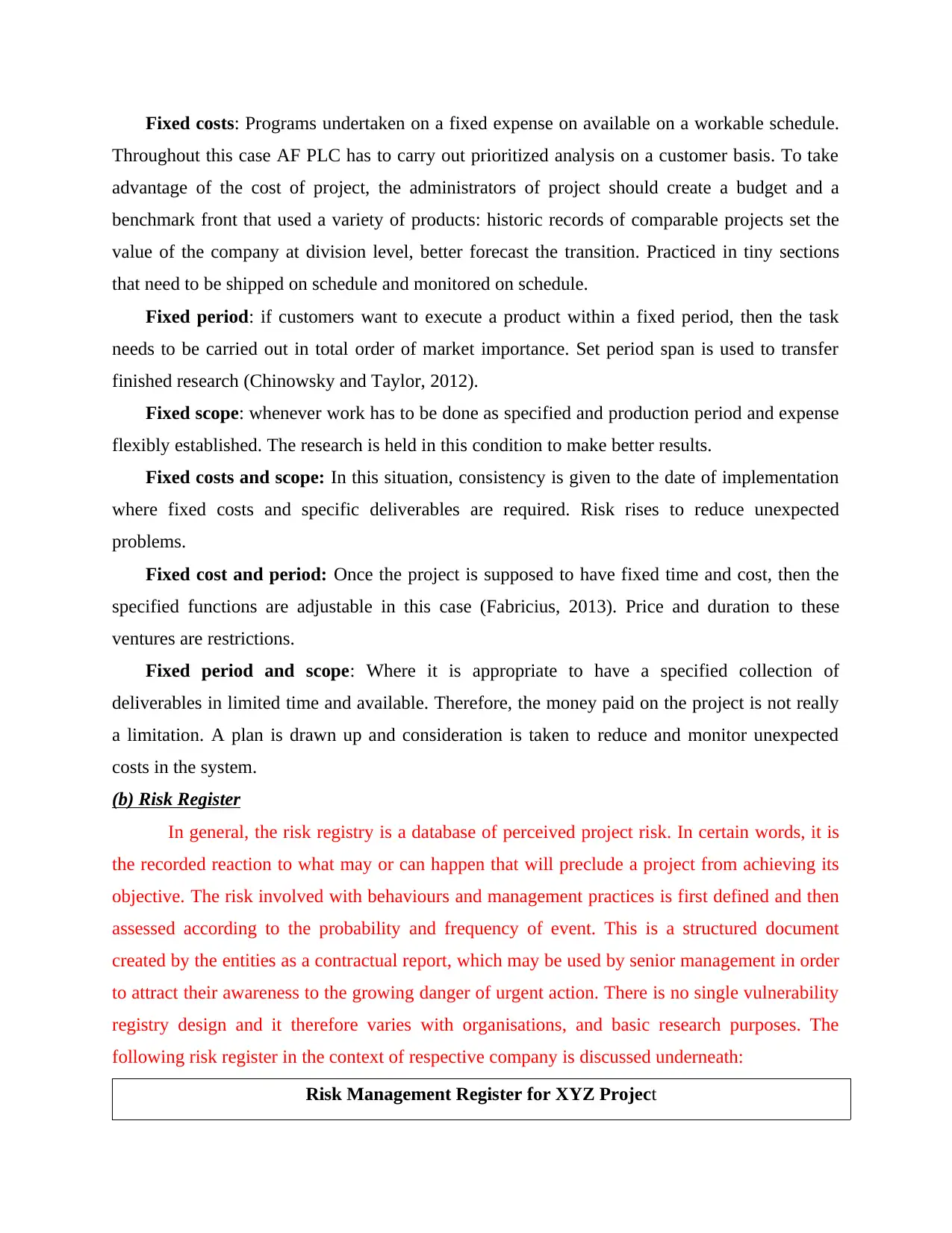
Fixed costs: Programs undertaken on a fixed expense on available on a workable schedule.
Throughout this case AF PLC has to carry out prioritized analysis on a customer basis. To take
advantage of the cost of project, the administrators of project should create a budget and a
benchmark front that used a variety of products: historic records of comparable projects set the
value of the company at division level, better forecast the transition. Practiced in tiny sections
that need to be shipped on schedule and monitored on schedule.
Fixed period: if customers want to execute a product within a fixed period, then the task
needs to be carried out in total order of market importance. Set period span is used to transfer
finished research (Chinowsky and Taylor, 2012).
Fixed scope: whenever work has to be done as specified and production period and expense
flexibly established. The research is held in this condition to make better results.
Fixed costs and scope: In this situation, consistency is given to the date of implementation
where fixed costs and specific deliverables are required. Risk rises to reduce unexpected
problems.
Fixed cost and period: Once the project is supposed to have fixed time and cost, then the
specified functions are adjustable in this case (Fabricius, 2013). Price and duration to these
ventures are restrictions.
Fixed period and scope: Where it is appropriate to have a specified collection of
deliverables in limited time and available. Therefore, the money paid on the project is not really
a limitation. A plan is drawn up and consideration is taken to reduce and monitor unexpected
costs in the system.
(b) Risk Register
In general, the risk registry is a database of perceived project risk. In certain words, it is
the recorded reaction to what may or can happen that will preclude a project from achieving its
objective. The risk involved with behaviours and management practices is first defined and then
assessed according to the probability and frequency of event. This is a structured document
created by the entities as a contractual report, which may be used by senior management in order
to attract their awareness to the growing danger of urgent action. There is no single vulnerability
registry design and it therefore varies with organisations, and basic research purposes. The
following risk register in the context of respective company is discussed underneath:
Risk Management Register for XYZ Project
Throughout this case AF PLC has to carry out prioritized analysis on a customer basis. To take
advantage of the cost of project, the administrators of project should create a budget and a
benchmark front that used a variety of products: historic records of comparable projects set the
value of the company at division level, better forecast the transition. Practiced in tiny sections
that need to be shipped on schedule and monitored on schedule.
Fixed period: if customers want to execute a product within a fixed period, then the task
needs to be carried out in total order of market importance. Set period span is used to transfer
finished research (Chinowsky and Taylor, 2012).
Fixed scope: whenever work has to be done as specified and production period and expense
flexibly established. The research is held in this condition to make better results.
Fixed costs and scope: In this situation, consistency is given to the date of implementation
where fixed costs and specific deliverables are required. Risk rises to reduce unexpected
problems.
Fixed cost and period: Once the project is supposed to have fixed time and cost, then the
specified functions are adjustable in this case (Fabricius, 2013). Price and duration to these
ventures are restrictions.
Fixed period and scope: Where it is appropriate to have a specified collection of
deliverables in limited time and available. Therefore, the money paid on the project is not really
a limitation. A plan is drawn up and consideration is taken to reduce and monitor unexpected
costs in the system.
(b) Risk Register
In general, the risk registry is a database of perceived project risk. In certain words, it is
the recorded reaction to what may or can happen that will preclude a project from achieving its
objective. The risk involved with behaviours and management practices is first defined and then
assessed according to the probability and frequency of event. This is a structured document
created by the entities as a contractual report, which may be used by senior management in order
to attract their awareness to the growing danger of urgent action. There is no single vulnerability
registry design and it therefore varies with organisations, and basic research purposes. The
following risk register in the context of respective company is discussed underneath:
Risk Management Register for XYZ Project

Risk Identification Assessment Response
Monitoring and
Control
Ref
eren
ce
Even
t Cause Effect
Pro
bab
ility
Im
pa
ct
P
x
L
St
ra
te
gy
Trigger Action
Resp
onsib
le
perso
n/s
Revi
ew
Freq
uenc
y
Status
date
and
general
notes
1 Finan
cing
shortf
all
Fund
constrai
nts-
allocati
on in
dispute
or
subject
to
interpre
tation
Postpo
ned
project
4 5 20 S
m
oo
the
n
Sponsor
s of the
initiativ
e refuse
to
guarante
e a
stable
amount
of
financin
g before
the
proposal
is
addresse
d
Carry out
another
fundraising
round and
receive
approval from
core
stakeholder
parties, such as
the Executive
Contributor
Proje
ct
Mana
ger,
Exec
utive
Spon
sor
Mon
thly
23.11.1
6
Revised
List.
Externa
l means
of
financin
g found
2 probl
em of
budge
ting
lackin
g
Unexpe
cted
circums
tances
contrib
uting to
Low
incom
e, or
can
result
in
5 6 30 Be
tte
r
pr
edi
cti
Predicti
on of
project
engineer
was
inexperi
Good review
and variability
scale.
Proje
ct
coord
inator
and
staff
Mon
thly
27/11/1
6
Monitoring and
Control
Ref
eren
ce
Even
t Cause Effect
Pro
bab
ility
Im
pa
ct
P
x
L
St
ra
te
gy
Trigger Action
Resp
onsib
le
perso
n/s
Revi
ew
Freq
uenc
y
Status
date
and
general
notes
1 Finan
cing
shortf
all
Fund
constrai
nts-
allocati
on in
dispute
or
subject
to
interpre
tation
Postpo
ned
project
4 5 20 S
m
oo
the
n
Sponsor
s of the
initiativ
e refuse
to
guarante
e a
stable
amount
of
financin
g before
the
proposal
is
addresse
d
Carry out
another
fundraising
round and
receive
approval from
core
stakeholder
parties, such as
the Executive
Contributor
Proje
ct
Mana
ger,
Exec
utive
Spon
sor
Mon
thly
23.11.1
6
Revised
List.
Externa
l means
of
financin
g found
2 probl
em of
budge
ting
lackin
g
Unexpe
cted
circums
tances
contrib
uting to
Low
incom
e, or
can
result
in
5 6 30 Be
tte
r
pr
edi
cti
Predicti
on of
project
engineer
was
inexperi
Good review
and variability
scale.
Proje
ct
coord
inator
and
staff
Mon
thly
27/11/1
6
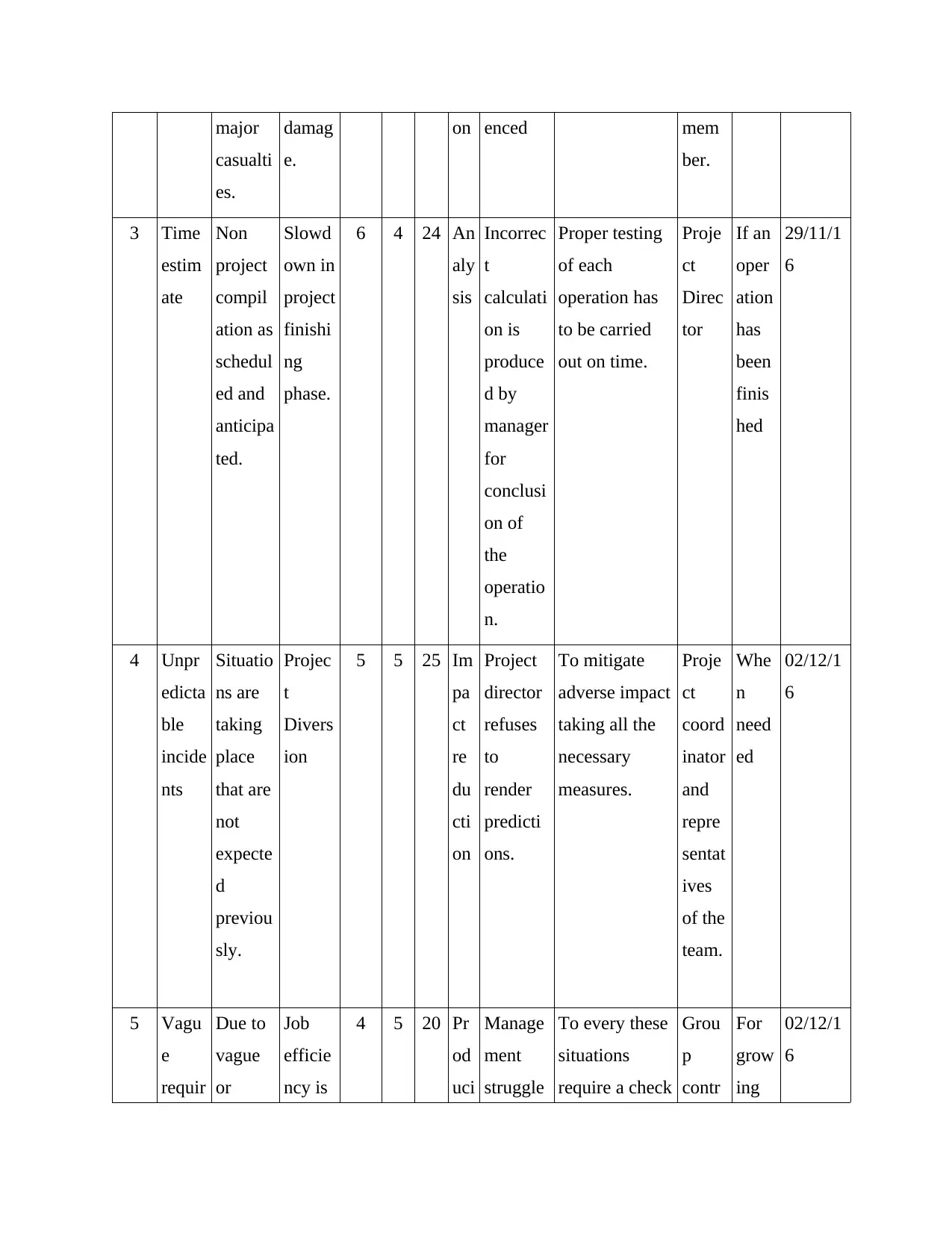
major
casualti
es.
damag
e.
on enced mem
ber.
3 Time
estim
ate
Non
project
compil
ation as
schedul
ed and
anticipa
ted.
Slowd
own in
project
finishi
ng
phase.
6 4 24 An
aly
sis
Incorrec
t
calculati
on is
produce
d by
manager
for
conclusi
on of
the
operatio
n.
Proper testing
of each
operation has
to be carried
out on time.
Proje
ct
Direc
tor
If an
oper
ation
has
been
finis
hed
29/11/1
6
4 Unpr
edicta
ble
incide
nts
Situatio
ns are
taking
place
that are
not
expecte
d
previou
sly.
Projec
t
Divers
ion
5 5 25 Im
pa
ct
re
du
cti
on
Project
director
refuses
to
render
predicti
ons.
To mitigate
adverse impact
taking all the
necessary
measures.
Proje
ct
coord
inator
and
repre
sentat
ives
of the
team.
Whe
n
need
ed
02/12/1
6
5 Vagu
e
requir
Due to
vague
or
Job
efficie
ncy is
4 5 20 Pr
od
uci
Manage
ment
struggle
To every these
situations
require a check
Grou
p
contr
For
grow
ing
02/12/1
6
casualti
es.
damag
e.
on enced mem
ber.
3 Time
estim
ate
Non
project
compil
ation as
schedul
ed and
anticipa
ted.
Slowd
own in
project
finishi
ng
phase.
6 4 24 An
aly
sis
Incorrec
t
calculati
on is
produce
d by
manager
for
conclusi
on of
the
operatio
n.
Proper testing
of each
operation has
to be carried
out on time.
Proje
ct
Direc
tor
If an
oper
ation
has
been
finis
hed
29/11/1
6
4 Unpr
edicta
ble
incide
nts
Situatio
ns are
taking
place
that are
not
expecte
d
previou
sly.
Projec
t
Divers
ion
5 5 25 Im
pa
ct
re
du
cti
on
Project
director
refuses
to
render
predicti
ons.
To mitigate
adverse impact
taking all the
necessary
measures.
Proje
ct
coord
inator
and
repre
sentat
ives
of the
team.
Whe
n
need
ed
02/12/1
6
5 Vagu
e
requir
Due to
vague
or
Job
efficie
ncy is
4 5 20 Pr
od
uci
Manage
ment
struggle
To every these
situations
require a check
Grou
p
contr
For
grow
ing
02/12/1
6
Paraphrase This Document
Need a fresh take? Get an instant paraphrase of this document with our AI Paraphraser
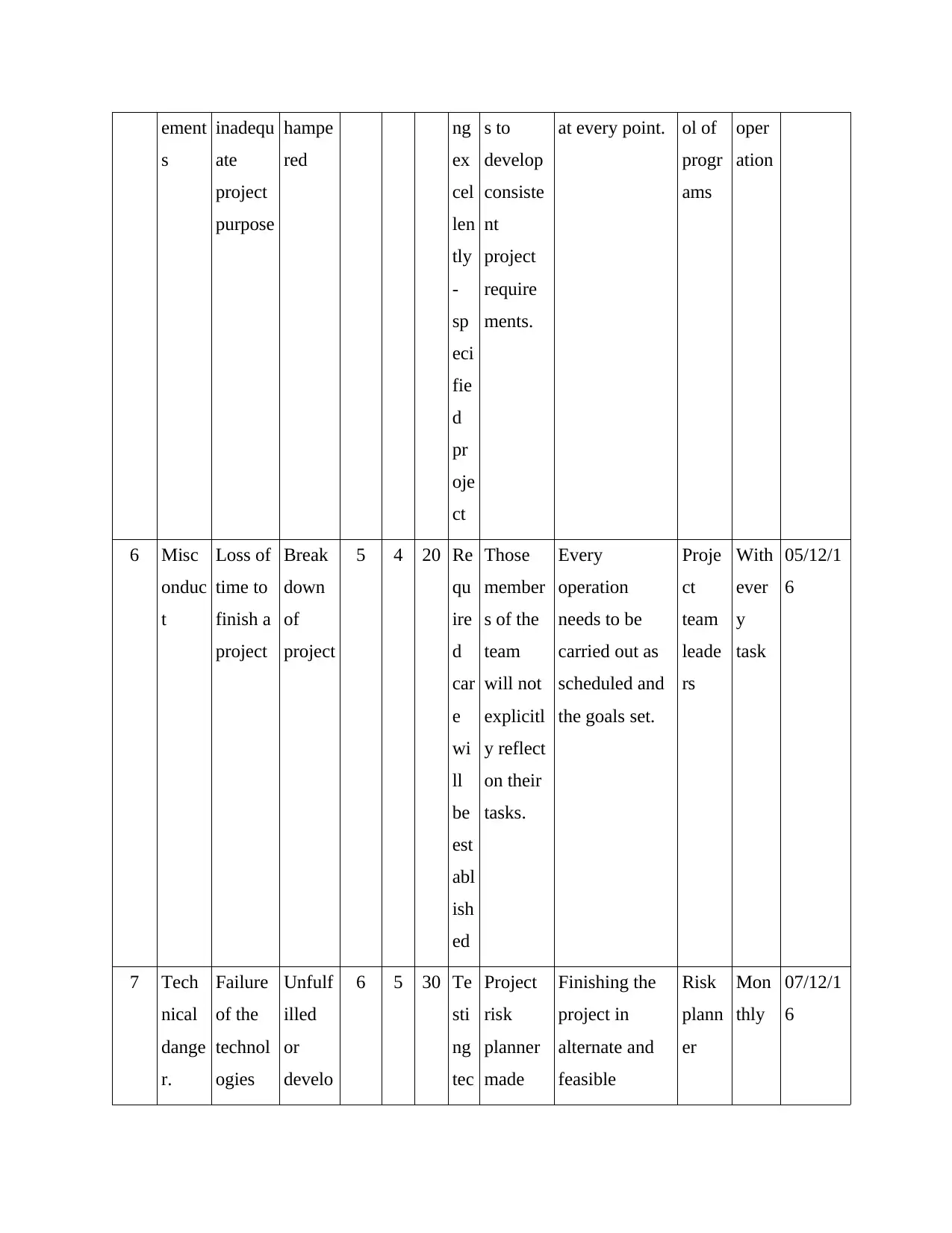
ement
s
inadequ
ate
project
purpose
hampe
red
ng
ex
cel
len
tly
-
sp
eci
fie
d
pr
oje
ct
s to
develop
consiste
nt
project
require
ments.
at every point. ol of
progr
ams
oper
ation
6 Misc
onduc
t
Loss of
time to
finish a
project
Break
down
of
project
5 4 20 Re
qu
ire
d
car
e
wi
ll
be
est
abl
ish
ed
Those
member
s of the
team
will not
explicitl
y reflect
on their
tasks.
Every
operation
needs to be
carried out as
scheduled and
the goals set.
Proje
ct
team
leade
rs
With
ever
y
task
05/12/1
6
7 Tech
nical
dange
r.
Failure
of the
technol
ogies
Unfulf
illed
or
develo
6 5 30 Te
sti
ng
tec
Project
risk
planner
made
Finishing the
project in
alternate and
feasible
Risk
plann
er
Mon
thly
07/12/1
6
s
inadequ
ate
project
purpose
hampe
red
ng
ex
cel
len
tly
-
sp
eci
fie
d
pr
oje
ct
s to
develop
consiste
nt
project
require
ments.
at every point. ol of
progr
ams
oper
ation
6 Misc
onduc
t
Loss of
time to
finish a
project
Break
down
of
project
5 4 20 Re
qu
ire
d
car
e
wi
ll
be
est
abl
ish
ed
Those
member
s of the
team
will not
explicitl
y reflect
on their
tasks.
Every
operation
needs to be
carried out as
scheduled and
the goals set.
Proje
ct
team
leade
rs
With
ever
y
task
05/12/1
6
7 Tech
nical
dange
r.
Failure
of the
technol
ogies
Unfulf
illed
or
develo
6 5 30 Te
sti
ng
tec
Project
risk
planner
made
Finishing the
project in
alternate and
feasible
Risk
plann
er
Mon
thly
07/12/1
6
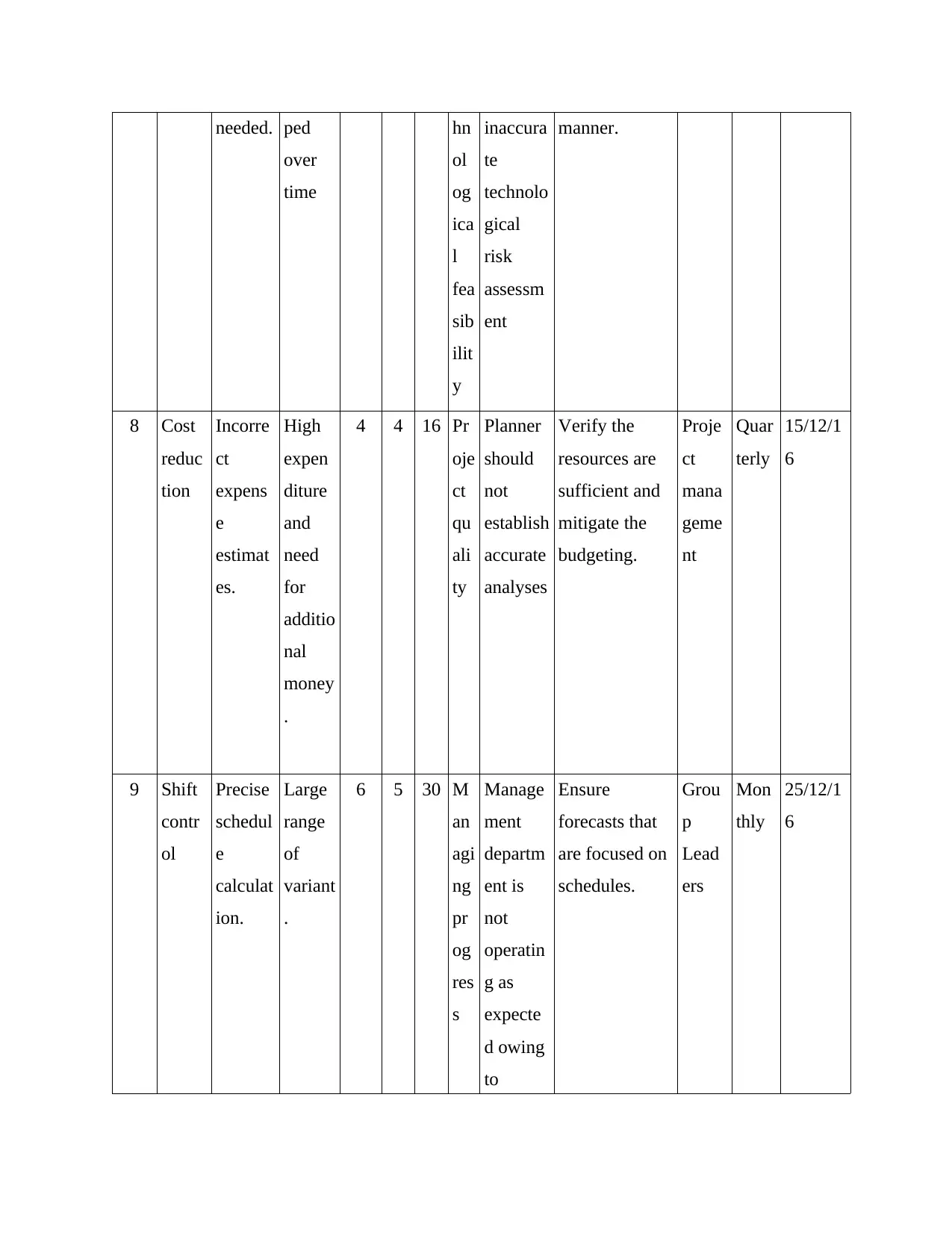
needed. ped
over
time
hn
ol
og
ica
l
fea
sib
ilit
y
inaccura
te
technolo
gical
risk
assessm
ent
manner.
8 Cost
reduc
tion
Incorre
ct
expens
e
estimat
es.
High
expen
diture
and
need
for
additio
nal
money
.
4 4 16 Pr
oje
ct
qu
ali
ty
Planner
should
not
establish
accurate
analyses
Verify the
resources are
sufficient and
mitigate the
budgeting.
Proje
ct
mana
geme
nt
Quar
terly
15/12/1
6
9 Shift
contr
ol
Precise
schedul
e
calculat
ion.
Large
range
of
variant
.
6 5 30 M
an
agi
ng
pr
og
res
s
Manage
ment
departm
ent is
not
operatin
g as
expecte
d owing
to
Ensure
forecasts that
are focused on
schedules.
Grou
p
Lead
ers
Mon
thly
25/12/1
6
over
time
hn
ol
og
ica
l
fea
sib
ilit
y
inaccura
te
technolo
gical
risk
assessm
ent
manner.
8 Cost
reduc
tion
Incorre
ct
expens
e
estimat
es.
High
expen
diture
and
need
for
additio
nal
money
.
4 4 16 Pr
oje
ct
qu
ali
ty
Planner
should
not
establish
accurate
analyses
Verify the
resources are
sufficient and
mitigate the
budgeting.
Proje
ct
mana
geme
nt
Quar
terly
15/12/1
6
9 Shift
contr
ol
Precise
schedul
e
calculat
ion.
Large
range
of
variant
.
6 5 30 M
an
agi
ng
pr
og
res
s
Manage
ment
departm
ent is
not
operatin
g as
expecte
d owing
to
Ensure
forecasts that
are focused on
schedules.
Grou
p
Lead
ers
Mon
thly
25/12/1
6
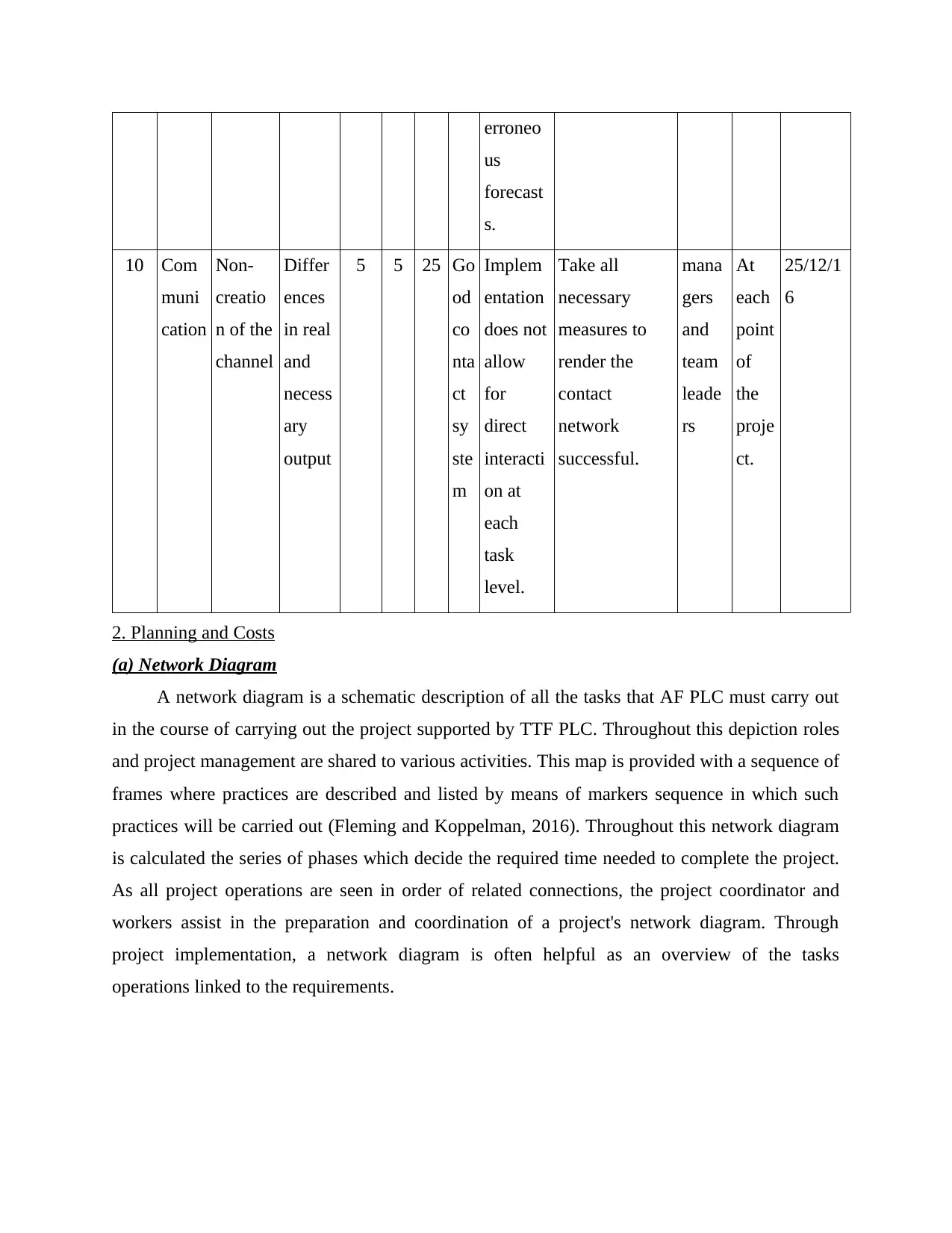
erroneo
us
forecast
s.
10 Com
muni
cation
Non-
creatio
n of the
channel
Differ
ences
in real
and
necess
ary
output
5 5 25 Go
od
co
nta
ct
sy
ste
m
Implem
entation
does not
allow
for
direct
interacti
on at
each
task
level.
Take all
necessary
measures to
render the
contact
network
successful.
mana
gers
and
team
leade
rs
At
each
point
of
the
proje
ct.
25/12/1
6
2. Planning and Costs
(a) Network Diagram
A network diagram is a schematic description of all the tasks that AF PLC must carry out
in the course of carrying out the project supported by TTF PLC. Throughout this depiction roles
and project management are shared to various activities. This map is provided with a sequence of
frames where practices are described and listed by means of markers sequence in which such
practices will be carried out (Fleming and Koppelman, 2016). Throughout this network diagram
is calculated the series of phases which decide the required time needed to complete the project.
As all project operations are seen in order of related connections, the project coordinator and
workers assist in the preparation and coordination of a project's network diagram. Through
project implementation, a network diagram is often helpful as an overview of the tasks
operations linked to the requirements.
us
forecast
s.
10 Com
muni
cation
Non-
creatio
n of the
channel
Differ
ences
in real
and
necess
ary
output
5 5 25 Go
od
co
nta
ct
sy
ste
m
Implem
entation
does not
allow
for
direct
interacti
on at
each
task
level.
Take all
necessary
measures to
render the
contact
network
successful.
mana
gers
and
team
leade
rs
At
each
point
of
the
proje
ct.
25/12/1
6
2. Planning and Costs
(a) Network Diagram
A network diagram is a schematic description of all the tasks that AF PLC must carry out
in the course of carrying out the project supported by TTF PLC. Throughout this depiction roles
and project management are shared to various activities. This map is provided with a sequence of
frames where practices are described and listed by means of markers sequence in which such
practices will be carried out (Fleming and Koppelman, 2016). Throughout this network diagram
is calculated the series of phases which decide the required time needed to complete the project.
As all project operations are seen in order of related connections, the project coordinator and
workers assist in the preparation and coordination of a project's network diagram. Through
project implementation, a network diagram is often helpful as an overview of the tasks
operations linked to the requirements.
Secure Best Marks with AI Grader
Need help grading? Try our AI Grader for instant feedback on your assignments.
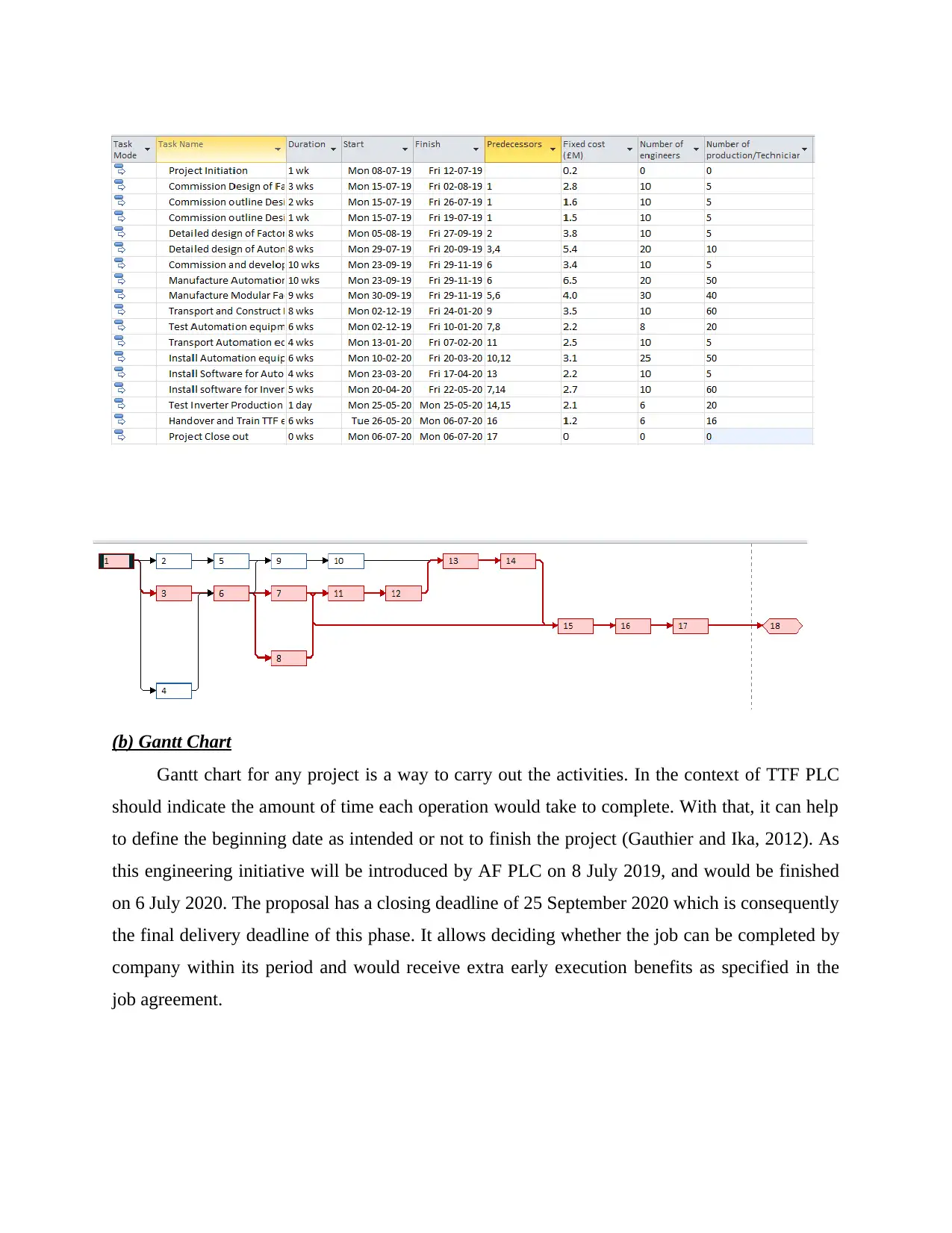
(b) Gantt Chart
Gantt chart for any project is a way to carry out the activities. In the context of TTF PLC
should indicate the amount of time each operation would take to complete. With that, it can help
to define the beginning date as intended or not to finish the project (Gauthier and Ika, 2012). As
this engineering initiative will be introduced by AF PLC on 8 July 2019, and would be finished
on 6 July 2020. The proposal has a closing deadline of 25 September 2020 which is consequently
the final delivery deadline of this phase. It allows deciding whether the job can be completed by
company within its period and would receive extra early execution benefits as specified in the
job agreement.
Gantt chart for any project is a way to carry out the activities. In the context of TTF PLC
should indicate the amount of time each operation would take to complete. With that, it can help
to define the beginning date as intended or not to finish the project (Gauthier and Ika, 2012). As
this engineering initiative will be introduced by AF PLC on 8 July 2019, and would be finished
on 6 July 2020. The proposal has a closing deadline of 25 September 2020 which is consequently
the final delivery deadline of this phase. It allows deciding whether the job can be completed by
company within its period and would receive extra early execution benefits as specified in the
job agreement.
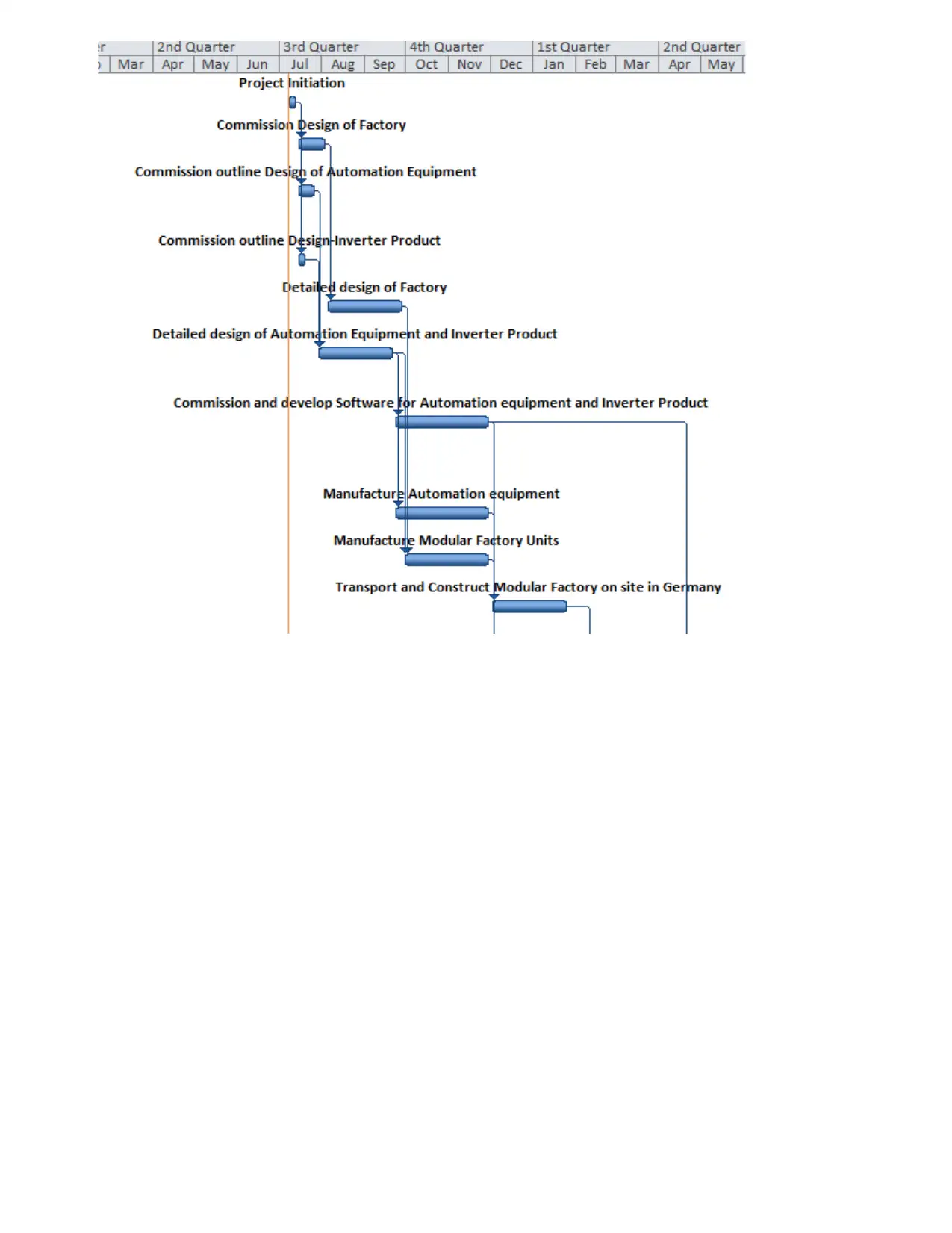
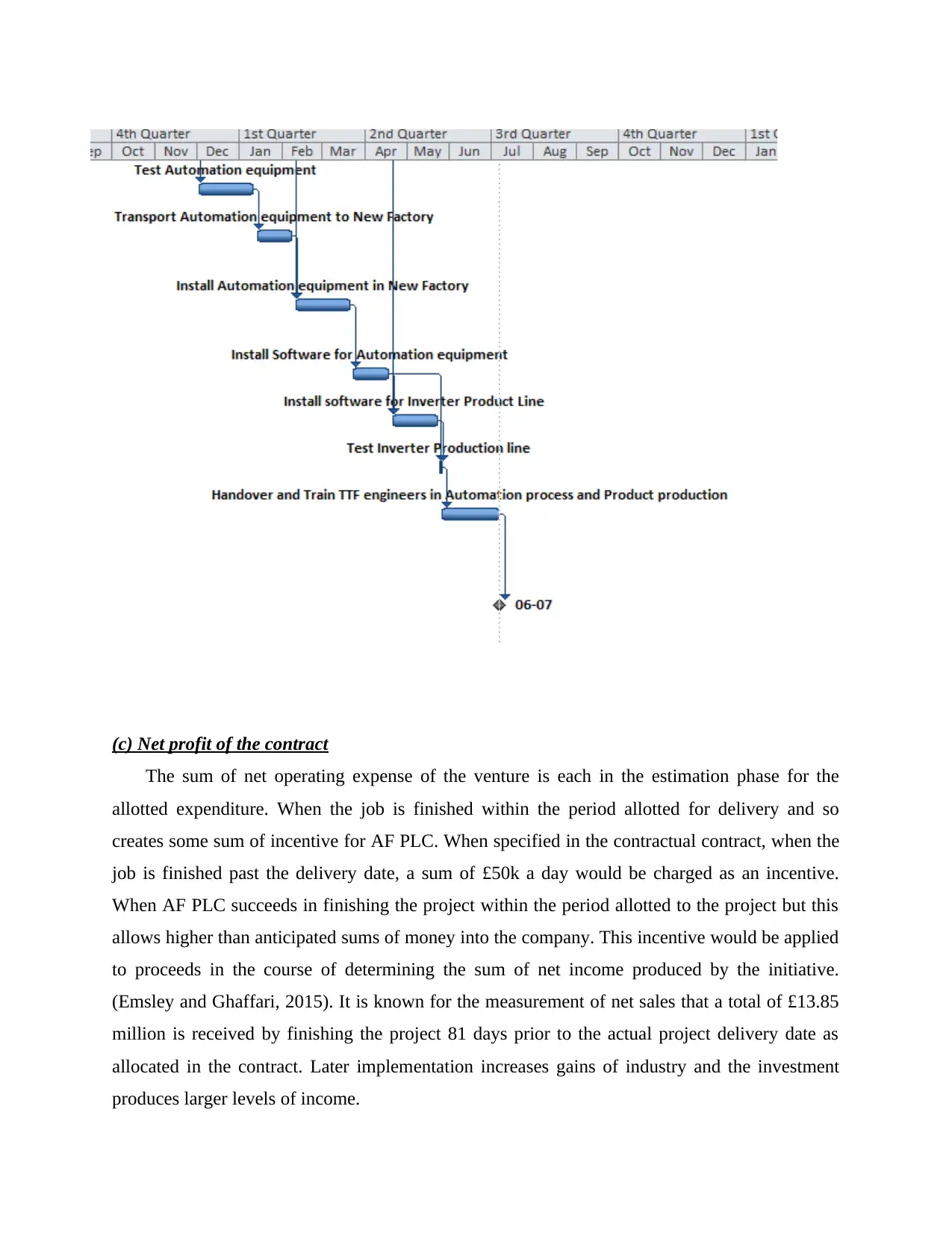
(c) Net profit of the contract
The sum of net operating expense of the venture is each in the estimation phase for the
allotted expenditure. When the job is finished within the period allotted for delivery and so
creates some sum of incentive for AF PLC. When specified in the contractual contract, when the
job is finished past the delivery date, a sum of £50k a day would be charged as an incentive.
When AF PLC succeeds in finishing the project within the period allotted to the project but this
allows higher than anticipated sums of money into the company. This incentive would be applied
to proceeds in the course of determining the sum of net income produced by the initiative.
(Emsley and Ghaffari, 2015). It is known for the measurement of net sales that a total of £13.85
million is received by finishing the project 81 days prior to the actual project delivery date as
allocated in the contract. Later implementation increases gains of industry and the investment
produces larger levels of income.
The sum of net operating expense of the venture is each in the estimation phase for the
allotted expenditure. When the job is finished within the period allotted for delivery and so
creates some sum of incentive for AF PLC. When specified in the contractual contract, when the
job is finished past the delivery date, a sum of £50k a day would be charged as an incentive.
When AF PLC succeeds in finishing the project within the period allotted to the project but this
allows higher than anticipated sums of money into the company. This incentive would be applied
to proceeds in the course of determining the sum of net income produced by the initiative.
(Emsley and Ghaffari, 2015). It is known for the measurement of net sales that a total of £13.85
million is received by finishing the project 81 days prior to the actual project delivery date as
allocated in the contract. Later implementation increases gains of industry and the investment
produces larger levels of income.
Paraphrase This Document
Need a fresh take? Get an instant paraphrase of this document with our AI Paraphraser
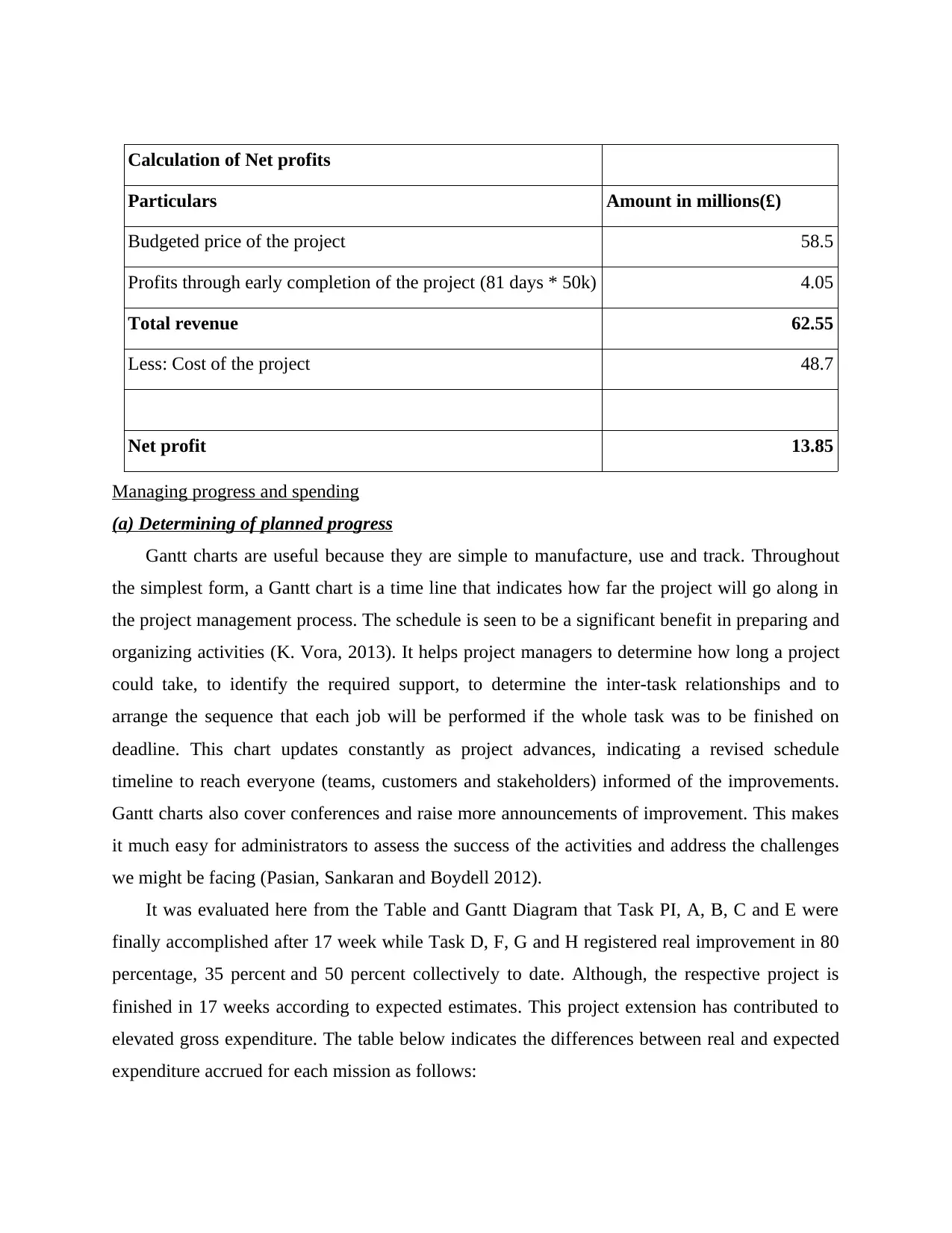
Calculation of Net profits
Particulars Amount in millions(£)
Budgeted price of the project 58.5
Profits through early completion of the project (81 days * 50k) 4.05
Total revenue 62.55
Less: Cost of the project 48.7
Net profit 13.85
Managing progress and spending
(a) Determining of planned progress
Gantt charts are useful because they are simple to manufacture, use and track. Throughout
the simplest form, a Gantt chart is a time line that indicates how far the project will go along in
the project management process. The schedule is seen to be a significant benefit in preparing and
organizing activities (K. Vora, 2013). It helps project managers to determine how long a project
could take, to identify the required support, to determine the inter-task relationships and to
arrange the sequence that each job will be performed if the whole task was to be finished on
deadline. This chart updates constantly as project advances, indicating a revised schedule
timeline to reach everyone (teams, customers and stakeholders) informed of the improvements.
Gantt charts also cover conferences and raise more announcements of improvement. This makes
it much easy for administrators to assess the success of the activities and address the challenges
we might be facing (Pasian, Sankaran and Boydell 2012).
It was evaluated here from the Table and Gantt Diagram that Task PI, A, B, C and E were
finally accomplished after 17 week while Task D, F, G and H registered real improvement in 80
percentage, 35 percent and 50 percent collectively to date. Although, the respective project is
finished in 17 weeks according to expected estimates. This project extension has contributed to
elevated gross expenditure. The table below indicates the differences between real and expected
expenditure accrued for each mission as follows:
Particulars Amount in millions(£)
Budgeted price of the project 58.5
Profits through early completion of the project (81 days * 50k) 4.05
Total revenue 62.55
Less: Cost of the project 48.7
Net profit 13.85
Managing progress and spending
(a) Determining of planned progress
Gantt charts are useful because they are simple to manufacture, use and track. Throughout
the simplest form, a Gantt chart is a time line that indicates how far the project will go along in
the project management process. The schedule is seen to be a significant benefit in preparing and
organizing activities (K. Vora, 2013). It helps project managers to determine how long a project
could take, to identify the required support, to determine the inter-task relationships and to
arrange the sequence that each job will be performed if the whole task was to be finished on
deadline. This chart updates constantly as project advances, indicating a revised schedule
timeline to reach everyone (teams, customers and stakeholders) informed of the improvements.
Gantt charts also cover conferences and raise more announcements of improvement. This makes
it much easy for administrators to assess the success of the activities and address the challenges
we might be facing (Pasian, Sankaran and Boydell 2012).
It was evaluated here from the Table and Gantt Diagram that Task PI, A, B, C and E were
finally accomplished after 17 week while Task D, F, G and H registered real improvement in 80
percentage, 35 percent and 50 percent collectively to date. Although, the respective project is
finished in 17 weeks according to expected estimates. This project extension has contributed to
elevated gross expenditure. The table below indicates the differences between real and expected
expenditure accrued for each mission as follows:
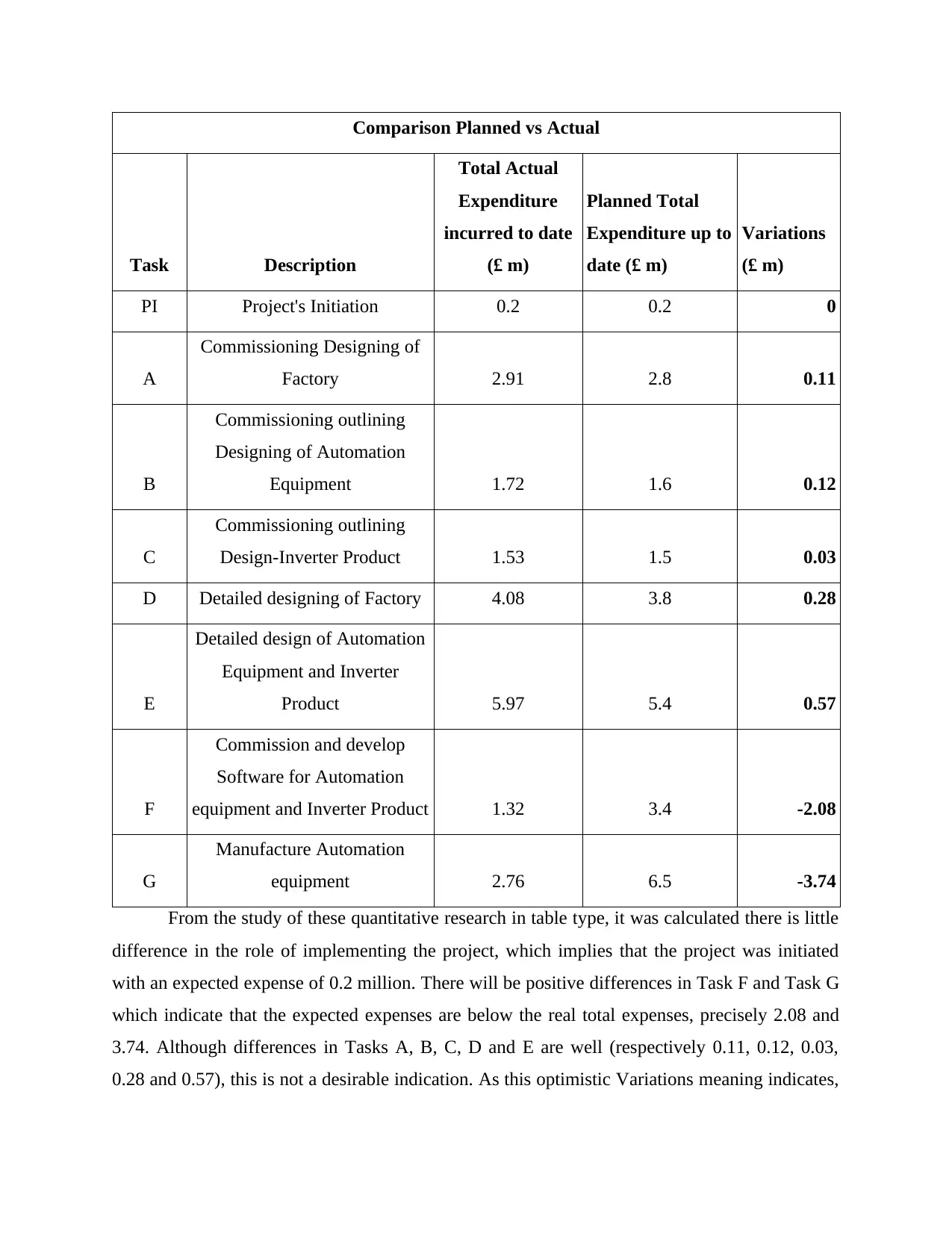
Comparison Planned vs Actual
Task Description
Total Actual
Expenditure
incurred to date
(£ m)
Planned Total
Expenditure up to
date (£ m)
Variations
(£ m)
PI Project's Initiation 0.2 0.2 0
A
Commissioning Designing of
Factory 2.91 2.8 0.11
B
Commissioning outlining
Designing of Automation
Equipment 1.72 1.6 0.12
C
Commissioning outlining
Design-Inverter Product 1.53 1.5 0.03
D Detailed designing of Factory 4.08 3.8 0.28
E
Detailed design of Automation
Equipment and Inverter
Product 5.97 5.4 0.57
F
Commission and develop
Software for Automation
equipment and Inverter Product 1.32 3.4 -2.08
G
Manufacture Automation
equipment 2.76 6.5 -3.74
From the study of these quantitative research in table type, it was calculated there is little
difference in the role of implementing the project, which implies that the project was initiated
with an expected expense of 0.2 million. There will be positive differences in Task F and Task G
which indicate that the expected expenses are below the real total expenses, precisely 2.08 and
3.74. Although differences in Tasks A, B, C, D and E are well (respectively 0.11, 0.12, 0.03,
0.28 and 0.57), this is not a desirable indication. As this optimistic Variations meaning indicates,
Task Description
Total Actual
Expenditure
incurred to date
(£ m)
Planned Total
Expenditure up to
date (£ m)
Variations
(£ m)
PI Project's Initiation 0.2 0.2 0
A
Commissioning Designing of
Factory 2.91 2.8 0.11
B
Commissioning outlining
Designing of Automation
Equipment 1.72 1.6 0.12
C
Commissioning outlining
Design-Inverter Product 1.53 1.5 0.03
D Detailed designing of Factory 4.08 3.8 0.28
E
Detailed design of Automation
Equipment and Inverter
Product 5.97 5.4 0.57
F
Commission and develop
Software for Automation
equipment and Inverter Product 1.32 3.4 -2.08
G
Manufacture Automation
equipment 2.76 6.5 -3.74
From the study of these quantitative research in table type, it was calculated there is little
difference in the role of implementing the project, which implies that the project was initiated
with an expected expense of 0.2 million. There will be positive differences in Task F and Task G
which indicate that the expected expenses are below the real total expenses, precisely 2.08 and
3.74. Although differences in Tasks A, B, C, D and E are well (respectively 0.11, 0.12, 0.03,
0.28 and 0.57), this is not a desirable indication. As this optimistic Variations meaning indicates,
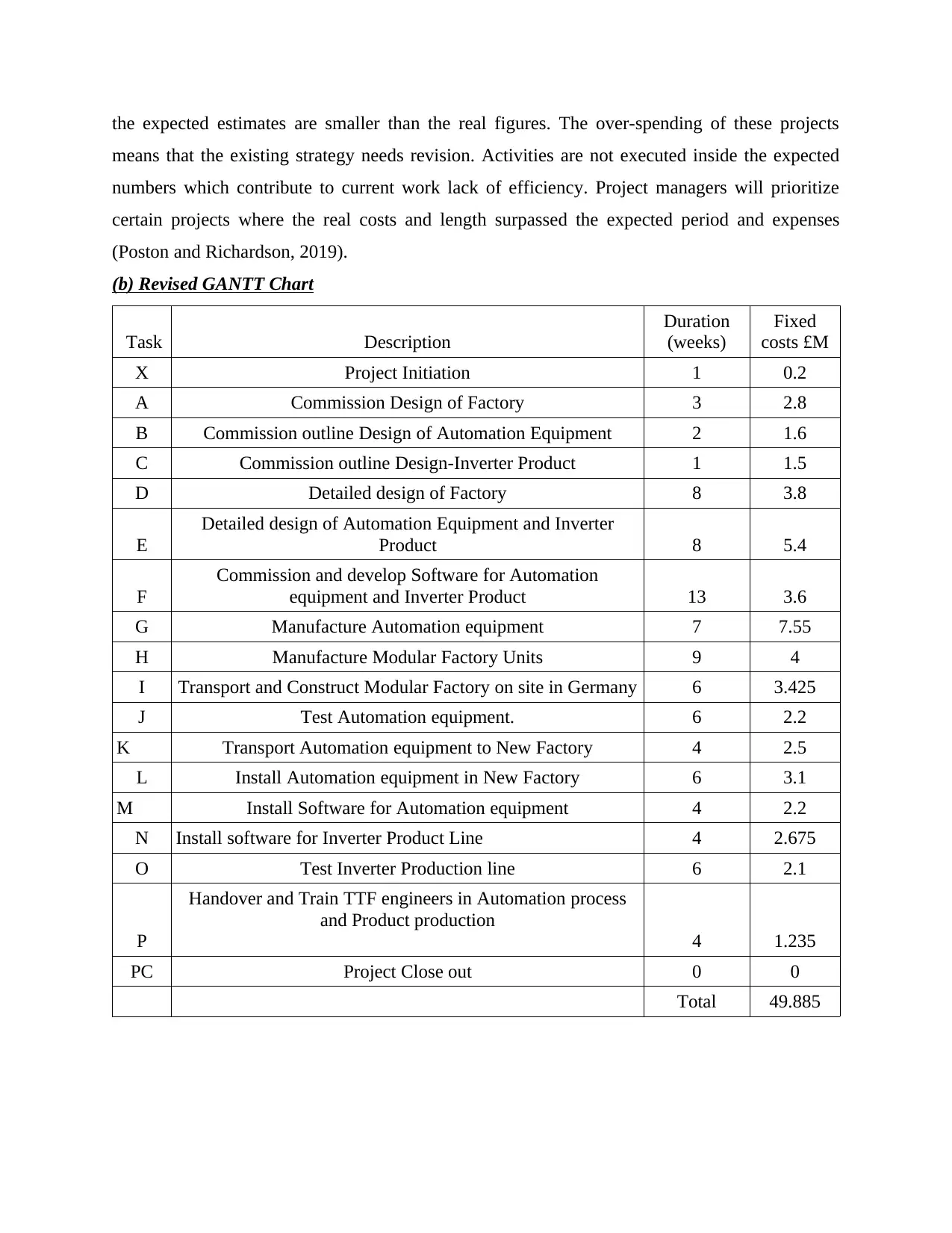
the expected estimates are smaller than the real figures. The over-spending of these projects
means that the existing strategy needs revision. Activities are not executed inside the expected
numbers which contribute to current work lack of efficiency. Project managers will prioritize
certain projects where the real costs and length surpassed the expected period and expenses
(Poston and Richardson, 2019).
(b) Revised GANTT Chart
Task Description
Duration
(weeks)
Fixed
costs £M
X Project Initiation 1 0.2
A Commission Design of Factory 3 2.8
B Commission outline Design of Automation Equipment 2 1.6
C Commission outline Design-Inverter Product 1 1.5
D Detailed design of Factory 8 3.8
E
Detailed design of Automation Equipment and Inverter
Product 8 5.4
F
Commission and develop Software for Automation
equipment and Inverter Product 13 3.6
G Manufacture Automation equipment 7 7.55
H Manufacture Modular Factory Units 9 4
I Transport and Construct Modular Factory on site in Germany 6 3.425
J Test Automation equipment. 6 2.2
K Transport Automation equipment to New Factory 4 2.5
L Install Automation equipment in New Factory 6 3.1
M Install Software for Automation equipment 4 2.2
N Install software for Inverter Product Line 4 2.675
O Test Inverter Production line 6 2.1
P
Handover and Train TTF engineers in Automation process
and Product production
4 1.235
PC Project Close out 0 0
Total 49.885
means that the existing strategy needs revision. Activities are not executed inside the expected
numbers which contribute to current work lack of efficiency. Project managers will prioritize
certain projects where the real costs and length surpassed the expected period and expenses
(Poston and Richardson, 2019).
(b) Revised GANTT Chart
Task Description
Duration
(weeks)
Fixed
costs £M
X Project Initiation 1 0.2
A Commission Design of Factory 3 2.8
B Commission outline Design of Automation Equipment 2 1.6
C Commission outline Design-Inverter Product 1 1.5
D Detailed design of Factory 8 3.8
E
Detailed design of Automation Equipment and Inverter
Product 8 5.4
F
Commission and develop Software for Automation
equipment and Inverter Product 13 3.6
G Manufacture Automation equipment 7 7.55
H Manufacture Modular Factory Units 9 4
I Transport and Construct Modular Factory on site in Germany 6 3.425
J Test Automation equipment. 6 2.2
K Transport Automation equipment to New Factory 4 2.5
L Install Automation equipment in New Factory 6 3.1
M Install Software for Automation equipment 4 2.2
N Install software for Inverter Product Line 4 2.675
O Test Inverter Production line 6 2.1
P
Handover and Train TTF engineers in Automation process
and Product production
4 1.235
PC Project Close out 0 0
Total 49.885
Secure Best Marks with AI Grader
Need help grading? Try our AI Grader for instant feedback on your assignments.
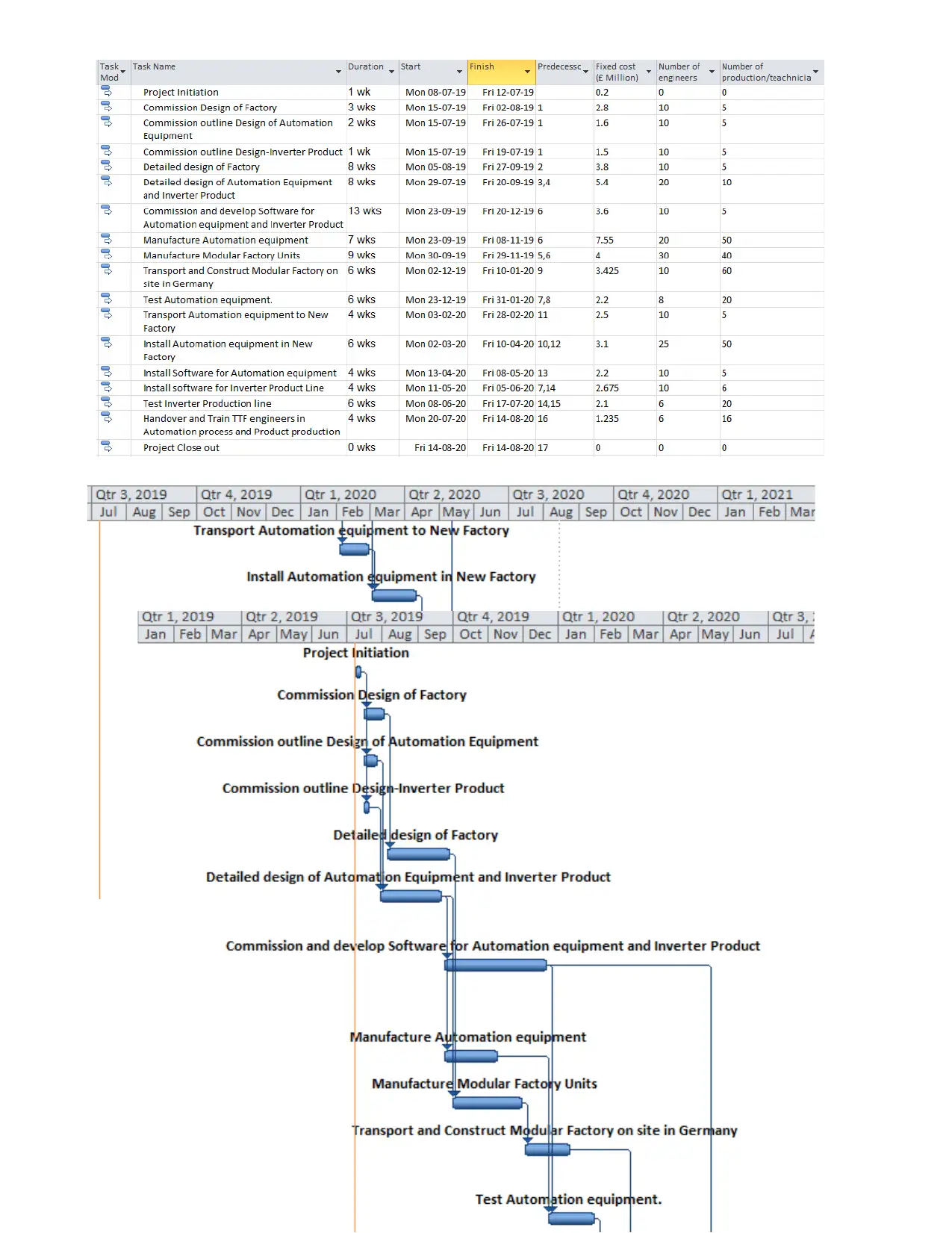

Earned Value Analysis and Acceleration
(a) Earned Value Analysis table
Earned Value and its use in Cost Control.
TASK BCWS ACWP %Progress BCWP
Planned Value Actual Cost Earned Value
PI $2,00,000.00 $2,00,000.00 100% $2,00,000.00
A $28,00,000.00 $29,10,000.00 100% $28,00,000.00
B $16,00,000.00 $17,20,000.00 100% $16,00,000.00
C $15,00,000.00 $15,30,000.00 100% $15,00,000.00
D $38,00,000.00 $40,80,000.00 80% $30,40,000.00
E $54,00,000.00 $59,70,000.00 100% $54,00,000.00
F $34,00,000.00 $13,20,000.00 35% $11,90,000.00
G $65,00,000.00 $27,60,000.00 35% $22,75,000.00
H $40,00,000.00 $27,50,000.00 50% $20,00,000.00
BAC $2,92,00,000.00 $2,32,40,000.00 $2,00,05,000.00
ACWP : Actual Cost of Work Performed
(a) Earned Value Analysis table
Earned Value and its use in Cost Control.
TASK BCWS ACWP %Progress BCWP
Planned Value Actual Cost Earned Value
PI $2,00,000.00 $2,00,000.00 100% $2,00,000.00
A $28,00,000.00 $29,10,000.00 100% $28,00,000.00
B $16,00,000.00 $17,20,000.00 100% $16,00,000.00
C $15,00,000.00 $15,30,000.00 100% $15,00,000.00
D $38,00,000.00 $40,80,000.00 80% $30,40,000.00
E $54,00,000.00 $59,70,000.00 100% $54,00,000.00
F $34,00,000.00 $13,20,000.00 35% $11,90,000.00
G $65,00,000.00 $27,60,000.00 35% $22,75,000.00
H $40,00,000.00 $27,50,000.00 50% $20,00,000.00
BAC $2,92,00,000.00 $2,32,40,000.00 $2,00,05,000.00
ACWP : Actual Cost of Work Performed

BCWP : Budgeted cost of Work Performed
BAC : Budget At Completion
BAC $2,92,00,000.00
PV $5,00,000.00
AC $2,32,40,000.00
EV $2,00,05,000.00
Cost Variance (CV = EV - AC) -$32,35,000.00
Cost Performance Index (CPI = EV/AC) 0.86
Schedule Variance (SV = EV - PV) $1,95,05,000.00
Schedule Performance Index (SPI = EV/PV) 40.01
Cumulative Planned
Value (PV)
200
000
300
000
0
460
000
0
610
000
0
990000
0
153000
00
187000
00
252000
00
292000
00
Actual Cost and Earned Value
Cumulative Actual Cost
(AC)
200
000
311
000
0
483
000
0
636
000
0
104400
00
164100
00
177300
00
204900
00
232400
00
Cumulative Earned
Value (EV)
200
000
300
000
0
460
000
0
610
000
0
914000
0
145400
00
157300
00
180050
00
200050
00
Project Performance Metrics
Cost Variance (CV =
EV - AC)
0 -
110
-
230
-
260
-
130000
-
187000
-
200000
-
248500
-
323500
BAC : Budget At Completion
BAC $2,92,00,000.00
PV $5,00,000.00
AC $2,32,40,000.00
EV $2,00,05,000.00
Cost Variance (CV = EV - AC) -$32,35,000.00
Cost Performance Index (CPI = EV/AC) 0.86
Schedule Variance (SV = EV - PV) $1,95,05,000.00
Schedule Performance Index (SPI = EV/PV) 40.01
Cumulative Planned
Value (PV)
200
000
300
000
0
460
000
0
610
000
0
990000
0
153000
00
187000
00
252000
00
292000
00
Actual Cost and Earned Value
Cumulative Actual Cost
(AC)
200
000
311
000
0
483
000
0
636
000
0
104400
00
164100
00
177300
00
204900
00
232400
00
Cumulative Earned
Value (EV)
200
000
300
000
0
460
000
0
610
000
0
914000
0
145400
00
157300
00
180050
00
200050
00
Project Performance Metrics
Cost Variance (CV =
EV - AC)
0 -
110
-
230
-
260
-
130000
-
187000
-
200000
-
248500
-
323500
Paraphrase This Document
Need a fresh take? Get an instant paraphrase of this document with our AI Paraphraser
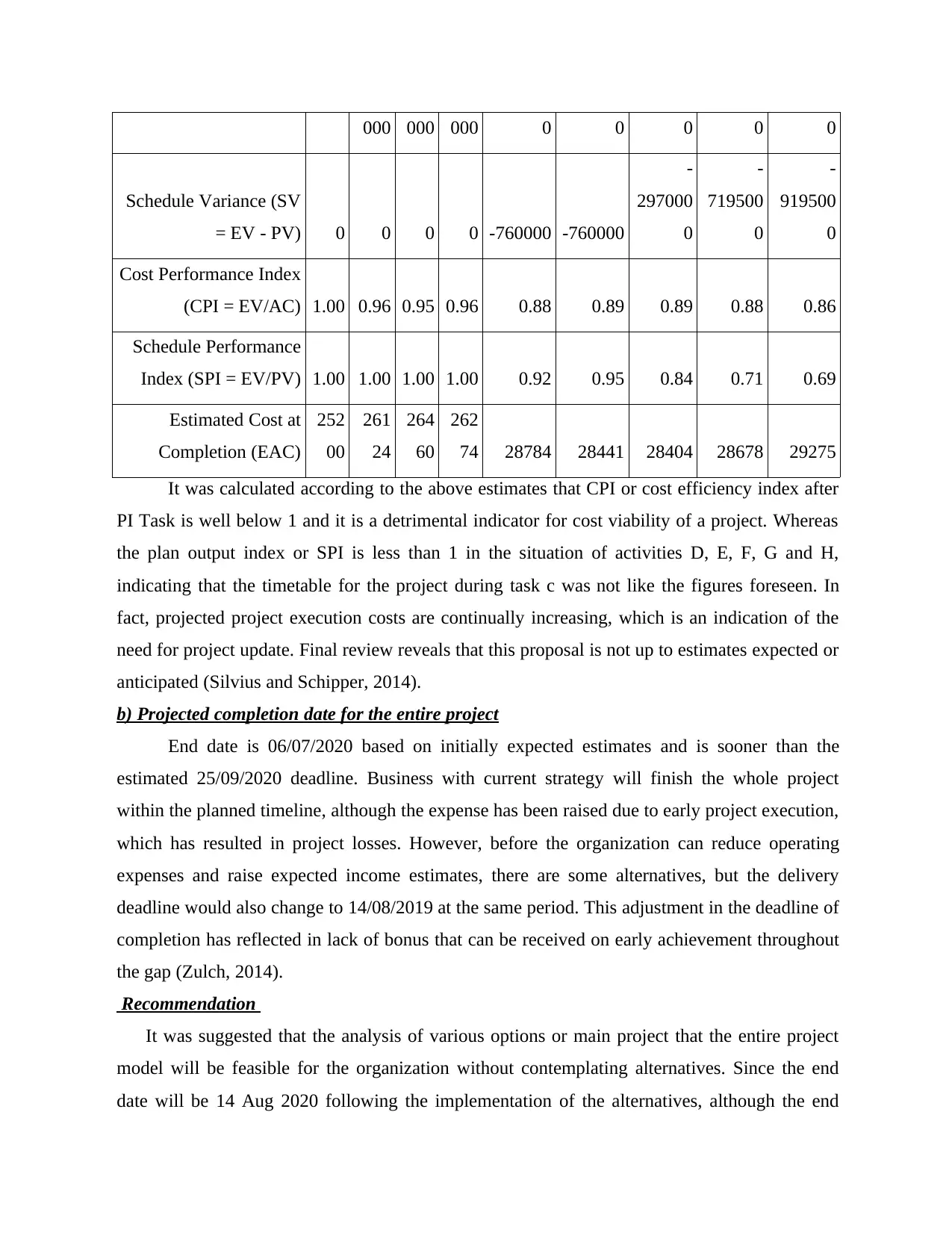
000 000 000 0 0 0 0 0
Schedule Variance (SV
= EV - PV) 0 0 0 0 -760000 -760000
-
297000
0
-
719500
0
-
919500
0
Cost Performance Index
(CPI = EV/AC) 1.00 0.96 0.95 0.96 0.88 0.89 0.89 0.88 0.86
Schedule Performance
Index (SPI = EV/PV) 1.00 1.00 1.00 1.00 0.92 0.95 0.84 0.71 0.69
Estimated Cost at
Completion (EAC)
252
00
261
24
264
60
262
74 28784 28441 28404 28678 29275
It was calculated according to the above estimates that CPI or cost efficiency index after
PI Task is well below 1 and it is a detrimental indicator for cost viability of a project. Whereas
the plan output index or SPI is less than 1 in the situation of activities D, E, F, G and H,
indicating that the timetable for the project during task c was not like the figures foreseen. In
fact, projected project execution costs are continually increasing, which is an indication of the
need for project update. Final review reveals that this proposal is not up to estimates expected or
anticipated (Silvius and Schipper, 2014).
b) Projected completion date for the entire project
End date is 06/07/2020 based on initially expected estimates and is sooner than the
estimated 25/09/2020 deadline. Business with current strategy will finish the whole project
within the planned timeline, although the expense has been raised due to early project execution,
which has resulted in project losses. However, before the organization can reduce operating
expenses and raise expected income estimates, there are some alternatives, but the delivery
deadline would also change to 14/08/2019 at the same period. This adjustment in the deadline of
completion has reflected in lack of bonus that can be received on early achievement throughout
the gap (Zulch, 2014).
Recommendation
It was suggested that the analysis of various options or main project that the entire project
model will be feasible for the organization without contemplating alternatives. Since the end
date will be 14 Aug 2020 following the implementation of the alternatives, although the end
Schedule Variance (SV
= EV - PV) 0 0 0 0 -760000 -760000
-
297000
0
-
719500
0
-
919500
0
Cost Performance Index
(CPI = EV/AC) 1.00 0.96 0.95 0.96 0.88 0.89 0.89 0.88 0.86
Schedule Performance
Index (SPI = EV/PV) 1.00 1.00 1.00 1.00 0.92 0.95 0.84 0.71 0.69
Estimated Cost at
Completion (EAC)
252
00
261
24
264
60
262
74 28784 28441 28404 28678 29275
It was calculated according to the above estimates that CPI or cost efficiency index after
PI Task is well below 1 and it is a detrimental indicator for cost viability of a project. Whereas
the plan output index or SPI is less than 1 in the situation of activities D, E, F, G and H,
indicating that the timetable for the project during task c was not like the figures foreseen. In
fact, projected project execution costs are continually increasing, which is an indication of the
need for project update. Final review reveals that this proposal is not up to estimates expected or
anticipated (Silvius and Schipper, 2014).
b) Projected completion date for the entire project
End date is 06/07/2020 based on initially expected estimates and is sooner than the
estimated 25/09/2020 deadline. Business with current strategy will finish the whole project
within the planned timeline, although the expense has been raised due to early project execution,
which has resulted in project losses. However, before the organization can reduce operating
expenses and raise expected income estimates, there are some alternatives, but the delivery
deadline would also change to 14/08/2019 at the same period. This adjustment in the deadline of
completion has reflected in lack of bonus that can be received on early achievement throughout
the gap (Zulch, 2014).
Recommendation
It was suggested that the analysis of various options or main project that the entire project
model will be feasible for the organization without contemplating alternatives. Since the end
date will be 14 Aug 2020 following the implementation of the alternatives, although the end
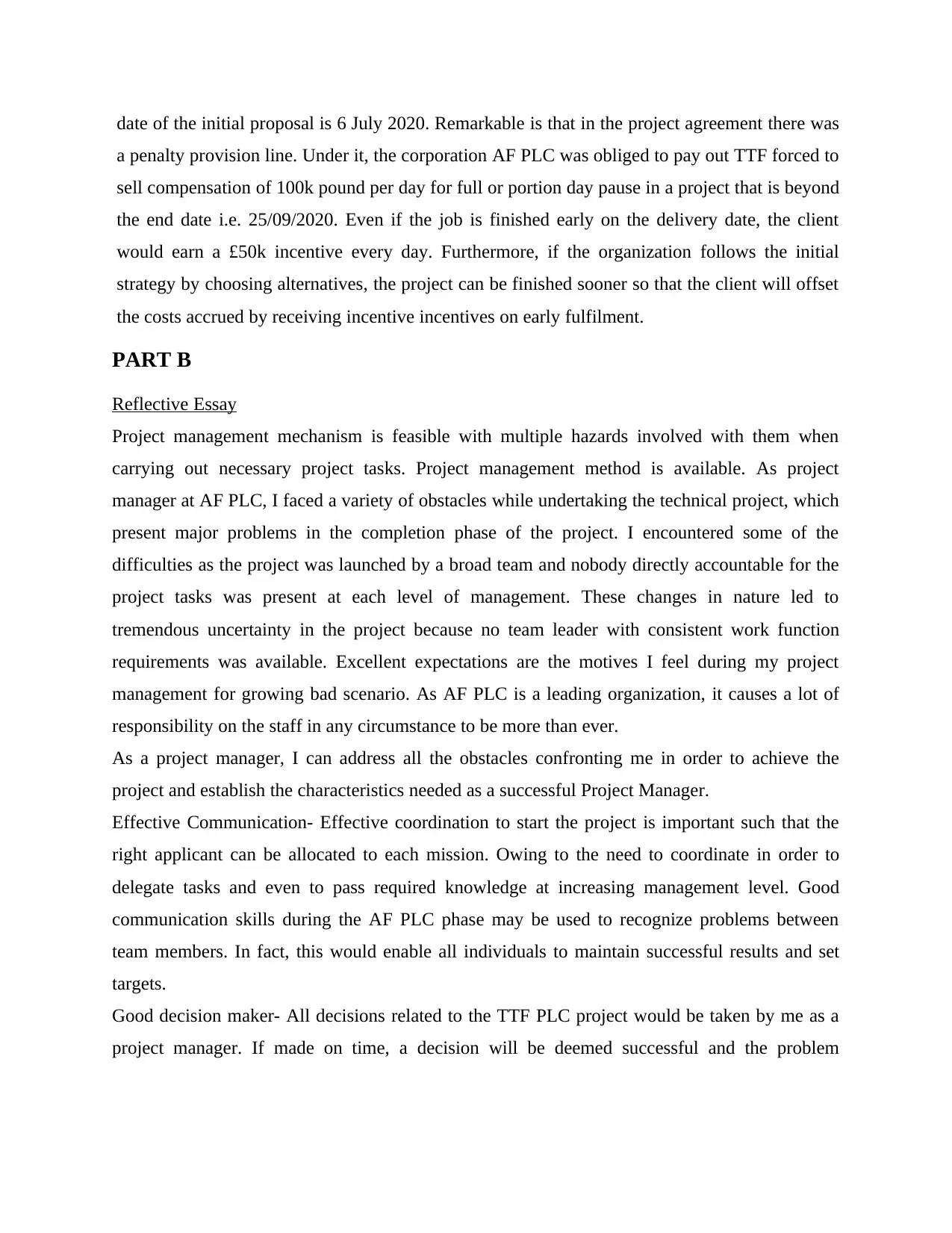
date of the initial proposal is 6 July 2020. Remarkable is that in the project agreement there was
a penalty provision line. Under it, the corporation AF PLC was obliged to pay out TTF forced to
sell compensation of 100k pound per day for full or portion day pause in a project that is beyond
the end date i.e. 25/09/2020. Even if the job is finished early on the delivery date, the client
would earn a £50k incentive every day. Furthermore, if the organization follows the initial
strategy by choosing alternatives, the project can be finished sooner so that the client will offset
the costs accrued by receiving incentive incentives on early fulfilment.
PART B
Reflective Essay
Project management mechanism is feasible with multiple hazards involved with them when
carrying out necessary project tasks. Project management method is available. As project
manager at AF PLC, I faced a variety of obstacles while undertaking the technical project, which
present major problems in the completion phase of the project. I encountered some of the
difficulties as the project was launched by a broad team and nobody directly accountable for the
project tasks was present at each level of management. These changes in nature led to
tremendous uncertainty in the project because no team leader with consistent work function
requirements was available. Excellent expectations are the motives I feel during my project
management for growing bad scenario. As AF PLC is a leading organization, it causes a lot of
responsibility on the staff in any circumstance to be more than ever.
As a project manager, I can address all the obstacles confronting me in order to achieve the
project and establish the characteristics needed as a successful Project Manager.
Effective Communication- Effective coordination to start the project is important such that the
right applicant can be allocated to each mission. Owing to the need to coordinate in order to
delegate tasks and even to pass required knowledge at increasing management level. Good
communication skills during the AF PLC phase may be used to recognize problems between
team members. In fact, this would enable all individuals to maintain successful results and set
targets.
Good decision maker- All decisions related to the TTF PLC project would be taken by me as a
project manager. If made on time, a decision will be deemed successful and the problem
a penalty provision line. Under it, the corporation AF PLC was obliged to pay out TTF forced to
sell compensation of 100k pound per day for full or portion day pause in a project that is beyond
the end date i.e. 25/09/2020. Even if the job is finished early on the delivery date, the client
would earn a £50k incentive every day. Furthermore, if the organization follows the initial
strategy by choosing alternatives, the project can be finished sooner so that the client will offset
the costs accrued by receiving incentive incentives on early fulfilment.
PART B
Reflective Essay
Project management mechanism is feasible with multiple hazards involved with them when
carrying out necessary project tasks. Project management method is available. As project
manager at AF PLC, I faced a variety of obstacles while undertaking the technical project, which
present major problems in the completion phase of the project. I encountered some of the
difficulties as the project was launched by a broad team and nobody directly accountable for the
project tasks was present at each level of management. These changes in nature led to
tremendous uncertainty in the project because no team leader with consistent work function
requirements was available. Excellent expectations are the motives I feel during my project
management for growing bad scenario. As AF PLC is a leading organization, it causes a lot of
responsibility on the staff in any circumstance to be more than ever.
As a project manager, I can address all the obstacles confronting me in order to achieve the
project and establish the characteristics needed as a successful Project Manager.
Effective Communication- Effective coordination to start the project is important such that the
right applicant can be allocated to each mission. Owing to the need to coordinate in order to
delegate tasks and even to pass required knowledge at increasing management level. Good
communication skills during the AF PLC phase may be used to recognize problems between
team members. In fact, this would enable all individuals to maintain successful results and set
targets.
Good decision maker- All decisions related to the TTF PLC project would be taken by me as a
project manager. If made on time, a decision will be deemed successful and the problem

involved will be handled better. As a manager, I have to improve my capacity, by careful
research, to make smart decisions and deliver positive results.
Technical Expertise- As AF PLC is a development management company; it will be accessible
with professional experience to the organization's Project Director. The management's decisions
would be feasible as they are rendered accessible with the correct resources and technological
knowledge is essential in the course of implementing the project decisions.
Leadership skills- A project manager is a team leader who takes all choices for the team and
conducts all tasks to accomplish set objectives. I need to improve these leadership qualities such
that my orders and duties as delegated to all project team members are implemented. That will
help to carry out the project in a particular way and the organization's reputation is created on the
competitive market.
CONCLUSION
This has been summarized from the aforementioned report that Project Management is
important because it guarantees the right execution strategy for operational targets is in effect. It
helps administrators to retain efficient influence of different projects as it includes detailed
project specifics such as job summary, planned length, no. of workers employed and the target
date for each assignment. Without proper project management, it is very challenging to establish
project execution dates and timelines that are over-ambitious or ignore equivalent project
performance estimates. This basically means that the projects are carried out late and over-
budgeting.
research, to make smart decisions and deliver positive results.
Technical Expertise- As AF PLC is a development management company; it will be accessible
with professional experience to the organization's Project Director. The management's decisions
would be feasible as they are rendered accessible with the correct resources and technological
knowledge is essential in the course of implementing the project decisions.
Leadership skills- A project manager is a team leader who takes all choices for the team and
conducts all tasks to accomplish set objectives. I need to improve these leadership qualities such
that my orders and duties as delegated to all project team members are implemented. That will
help to carry out the project in a particular way and the organization's reputation is created on the
competitive market.
CONCLUSION
This has been summarized from the aforementioned report that Project Management is
important because it guarantees the right execution strategy for operational targets is in effect. It
helps administrators to retain efficient influence of different projects as it includes detailed
project specifics such as job summary, planned length, no. of workers employed and the target
date for each assignment. Without proper project management, it is very challenging to establish
project execution dates and timelines that are over-ambitious or ignore equivalent project
performance estimates. This basically means that the projects are carried out late and over-
budgeting.
Secure Best Marks with AI Grader
Need help grading? Try our AI Grader for instant feedback on your assignments.
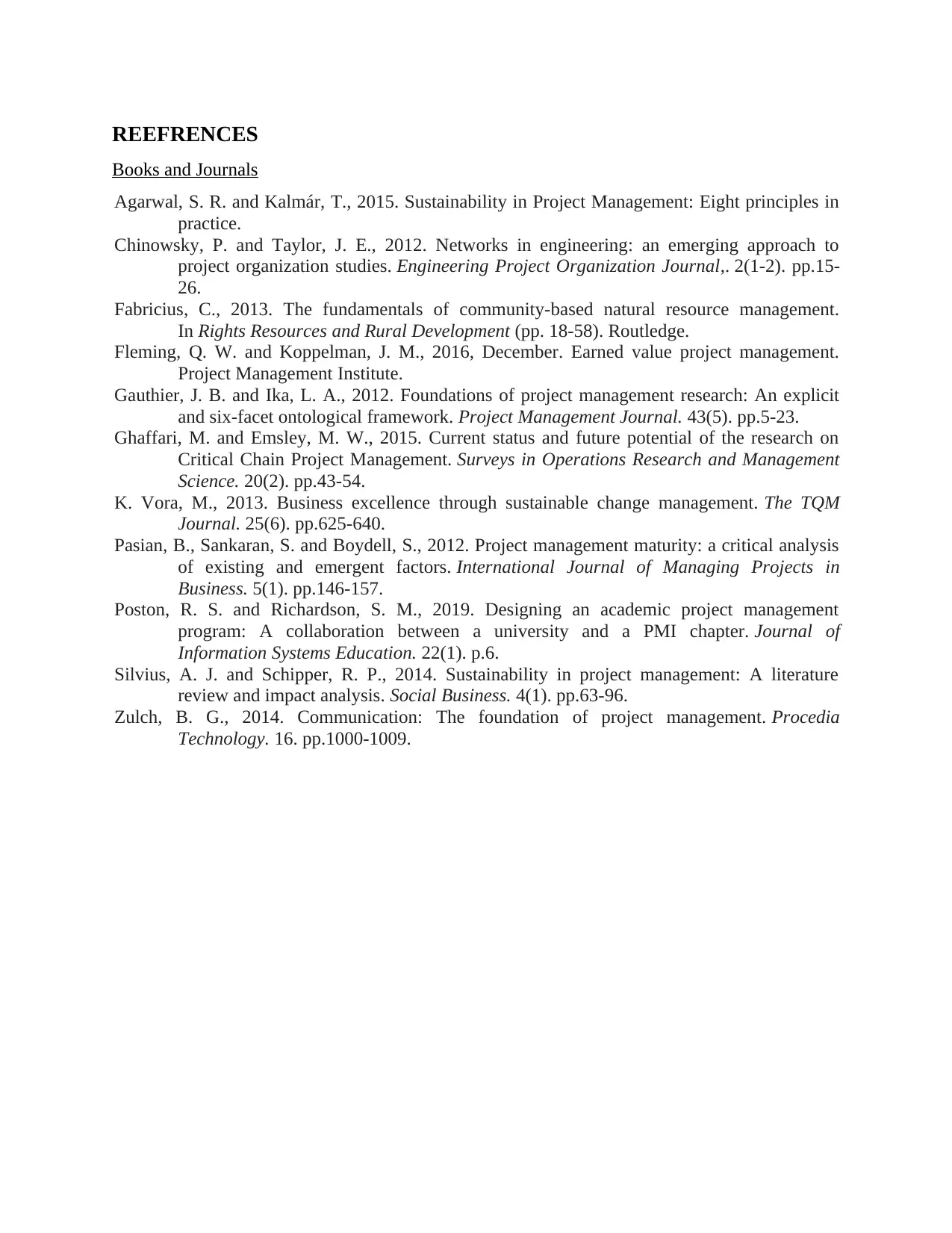
REEFRENCES
Books and Journals
Agarwal, S. R. and Kalmár, T., 2015. Sustainability in Project Management: Eight principles in
practice.
Chinowsky, P. and Taylor, J. E., 2012. Networks in engineering: an emerging approach to
project organization studies. Engineering Project Organization Journal,. 2(1-2). pp.15-
26.
Fabricius, C., 2013. The fundamentals of community-based natural resource management.
In Rights Resources and Rural Development (pp. 18-58). Routledge.
Fleming, Q. W. and Koppelman, J. M., 2016, December. Earned value project management.
Project Management Institute.
Gauthier, J. B. and Ika, L. A., 2012. Foundations of project management research: An explicit
and six-facet ontological framework. Project Management Journal. 43(5). pp.5-23.
Ghaffari, M. and Emsley, M. W., 2015. Current status and future potential of the research on
Critical Chain Project Management. Surveys in Operations Research and Management
Science. 20(2). pp.43-54.
K. Vora, M., 2013. Business excellence through sustainable change management. The TQM
Journal. 25(6). pp.625-640.
Pasian, B., Sankaran, S. and Boydell, S., 2012. Project management maturity: a critical analysis
of existing and emergent factors. International Journal of Managing Projects in
Business. 5(1). pp.146-157.
Poston, R. S. and Richardson, S. M., 2019. Designing an academic project management
program: A collaboration between a university and a PMI chapter. Journal of
Information Systems Education. 22(1). p.6.
Silvius, A. J. and Schipper, R. P., 2014. Sustainability in project management: A literature
review and impact analysis. Social Business. 4(1). pp.63-96.
Zulch, B. G., 2014. Communication: The foundation of project management. Procedia
Technology. 16. pp.1000-1009.
Books and Journals
Agarwal, S. R. and Kalmár, T., 2015. Sustainability in Project Management: Eight principles in
practice.
Chinowsky, P. and Taylor, J. E., 2012. Networks in engineering: an emerging approach to
project organization studies. Engineering Project Organization Journal,. 2(1-2). pp.15-
26.
Fabricius, C., 2013. The fundamentals of community-based natural resource management.
In Rights Resources and Rural Development (pp. 18-58). Routledge.
Fleming, Q. W. and Koppelman, J. M., 2016, December. Earned value project management.
Project Management Institute.
Gauthier, J. B. and Ika, L. A., 2012. Foundations of project management research: An explicit
and six-facet ontological framework. Project Management Journal. 43(5). pp.5-23.
Ghaffari, M. and Emsley, M. W., 2015. Current status and future potential of the research on
Critical Chain Project Management. Surveys in Operations Research and Management
Science. 20(2). pp.43-54.
K. Vora, M., 2013. Business excellence through sustainable change management. The TQM
Journal. 25(6). pp.625-640.
Pasian, B., Sankaran, S. and Boydell, S., 2012. Project management maturity: a critical analysis
of existing and emergent factors. International Journal of Managing Projects in
Business. 5(1). pp.146-157.
Poston, R. S. and Richardson, S. M., 2019. Designing an academic project management
program: A collaboration between a university and a PMI chapter. Journal of
Information Systems Education. 22(1). p.6.
Silvius, A. J. and Schipper, R. P., 2014. Sustainability in project management: A literature
review and impact analysis. Social Business. 4(1). pp.63-96.
Zulch, B. G., 2014. Communication: The foundation of project management. Procedia
Technology. 16. pp.1000-1009.
1 out of 23
Related Documents
Your All-in-One AI-Powered Toolkit for Academic Success.
+13062052269
info@desklib.com
Available 24*7 on WhatsApp / Email
![[object Object]](/_next/static/media/star-bottom.7253800d.svg)
Unlock your academic potential
© 2024 | Zucol Services PVT LTD | All rights reserved.





